Life as Art
A Romanian Jew in Italy
Paradise Lost
No Exit
An Aborted Escape
On Paperwork Trail
Internment
Saul Steinberg's Journal, December 1940 - June 1941
“I didn’t want to accept the reality, the betrayal—
the way dearest Italy turned into Romania, hellish homeland.” 2
Life as Art
For most of his adult life, Saul Steinberg (1914-1999) drew maps—maps of real or imaginary locations, maps of words and of concepts. Often the maps are of actual places refracted through the artist’s mental constructs, as in View of the World from 9th Avenue, his famous March 29, 1976 New Yorker cover, which, reprinted as a poster, copied, and appropriated for many other cities of the world, became his personal nightmare; even today, it remains the icon that most easily identifies him.3 There is, however, another splendid map, completed ten years earlier; although intended for The New Yorker, it was never fully published in Steinberg’s lifetime (Fig. 1).4 Entitled Autogeography, it is a bird’s-eye view of a green territory dotted with the names of many locales, large and small, from every corner of the world. A very blue, winding river flows through the territory, and on the bottom right it skirts a small lake with an island. On the island is the word “Milano,” while on the shore northeast of the island we find a locality named “Tortoreto (Teramo).”
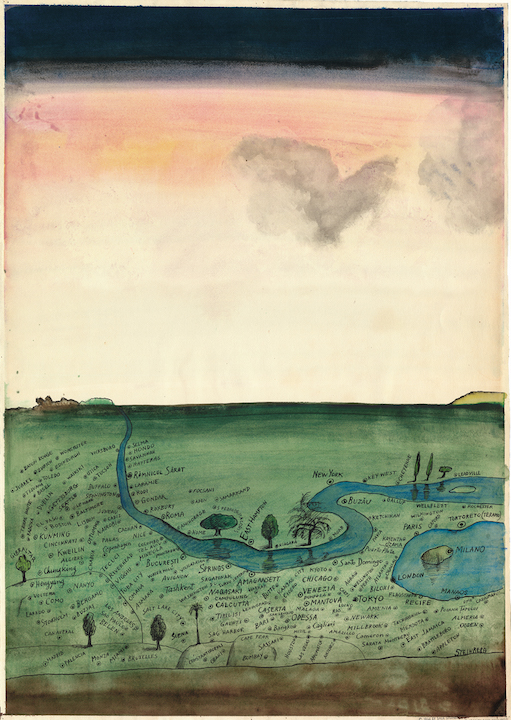
The Saul Steinberg Foundation, New York.
© The Saul Steinberg Foundation/Artists Rights Society (ARS) New York
Young Steinberg lived for more than seven years in Milan (1933-41), arriving from his native Bucharest to enroll in architecture school. In Milan, he studied, loved, began to draw and publish, and formed enduring friendships. By mid-1938, however, the institution of the Fascist racial laws made his Italian sojourn perilous, and he began to seek safe haven elsewhere. In late April 1941, he was arrested as a Romanian Jew and sent to an internment camp in the small Abruzzi town of Tortoreto in the province of Teramo. The experience would continue to haunt him and to punctuate his correspondence. But never—at least not during his lifetime—did it translate into a coherent and conscious narrative. Steinberg feared “autobiography—the last refuge of the scoundrel.”5
Nevertheless, in the mid-1970s, Steinberg’s friend Aldo Buzzi convinced him to tape record memories of his life, which Buzzi planned to edit for publication. However fascinated Steinberg was by this exercise, as well as admiring of Buzzi’s editing skills, he never allowed the book to be published. As late as 1995, four years before his death, Steinberg thanked the Italian publishing house Adelphi for its willingness to print the book, but rejected the idea of seeing “a tragic part of my life treated with allegria!”6 He was especially hostile to a public airing of his Italian period, including the cartoons he published in the later 1930s in Bertoldo and Settebello, humorous satirical newspapers (Fig. 4, 5). Such works represented a moment in his past too much involved with “jokes.” But he could also be more vehement on the subject of publishing these cartoons. To one proposal he responded angrily, ‘what a bad idea! Blackmail!’; he feared that “dark horrors” might be exposed.7
Even in calmer moments, Steinberg remained averse to biographical inquiries, so that until his death, only fragments of his life story have surfaced. Some things he told to interviewers, others in the chronology he dictated for the catalogue of his 1978 retrospective at the Whitney Museum of American Art, New York.8 Such autobiographical comments, however, were often designed to be more provocative and concealing than informative. Other hints about Steinberg’s life could be found in his art, where he hid clues (as in Autogeography), but these clues are incomprehensible without biographical facts.9
Only after the death of his friend did Buzzi publish the short book entitled Reflections and Shadows, an edited version of Steinberg’s taped narrative of the 1970s, followed by a selection of the letters Steinberg wrote to him over a fifty-year period.10 Since then, the work of Joel Smith has greatly expanded our store of biographical data.11 Yet the Italian period of Steinberg’s life remains the least known.
The present essay seeks to shed light on that time, from Steinberg’s enrollment in 1933 as an architecture student in Milan to his imprisonment and flight from Italy in 1941. What happened during that seven-year sojourn is both a personal history—Steinberg’s happy embrace of Western culture and the beginning of his career as a draftsman—and, with the imposition of racial laws in 1938, part of a collective history of Fascist anti-Semitism. His was one case among thousands in the most widespread and dramatic historical event that befell foreign Jews living in Italy at the beginning of World War II. Steinberg’s arrest and internment, his struggle to obtain the necessary papers, and his final escape are recorded in the journal he kept from late 1940, which is published here, along with some of the drawings that illustrate it. Enlivening the entries are the constant shifts between the pleasures or irritations of daily life and the dread of being entrapped in Mussolini’s racial policies.
BACK
A Romanian Jew in Italy
Saul was the son of Moritz Steinberg, a printer-bookbinder who had a small business manufacturing boxes and cardboard wrapping materials. His birth certificate says he was born on June 15, 1914 (Julian calendar), in Râmnicul Sărat, Romania (100 miles north of Bucharest; on the great river of life in Autogeography, the town is located near the river’s narrow source at left).12 But he was to grow up in the Romanian capital, attending elementary school, then high school, and spending one year as a philosophy student at the university, before seeking admission to the School of Architecture at the University of Bucharest. Decades later, speaking to his former schoolmate Eugen Campus, he explained his decision to study architecture and his failed attempt at the admission exam:
If I had declared that I wanted to dedicate myself to art, my parents would have not supported me in school. So I declared that I wanted to study architecture. My parents agreed to this serious and prestigious profession, almost on the same level with medicine. Matchmakers started to show up at our house, offering rich partners for the future architect, even agreeing to sponsor my studies for a prolonged duration. Fortunately, I did not pass the admission examination, and so I left for Milan.13
He left in November 1933. Steinberg’s Jewishness may have had something to do with his failure to pass the entrance examination. Since the early 1920s, anti-Semitic groups in Romania had been clamoring for the institution of numerus clausus in universities: a limit to “foreign” (e.g., mostly Jewish) students to further the “Romanization” of professions. Numerus clausus was not introduced until 1938, but in 1933 – the very year Steinberg’s application was rejected – “special entrance examinations were introduced and Jewish candidates were deliberately failed.”14 Even the few Jewish students who managed to get admitted (four out of 160 at the School of Medicine in 1935) were subject to physical attack by fellow students and militants and were hardly able to attend classes. That was Steinberg’s own experience: “I was a college student for a year,” he would recall later, “but I hardly went to school because there was an atmosphere of brutality.” More and more young Romanian Jews thus emigrated to France or Italy for their studies.15
This increasingly anti-Semitic climate of Romania was something Steinberg would remember all his life; coupled with an occasional expression of nostalgia for a childhood home was a vehement rejection of the society, culture, and language of the country.
My childhood, my adolescence in Romania were a little like being a black in the state of Mississippi.
It will be difficult…to understand—especially for a child—life in an anti-Semitic country such as Romania….The country is a cesspool.
In [the Romanian] language I have been humiliated, beaten, cursed and worse—for being Jewish, the only satisfaction those savages had….
I have what they call phantom pain, that is, strong and specific pain in the big toe of a leg amputated years before. It’s the pain of the Romanian patriot I was until the age of 8 or 10, when the anti-Semitism of the place made me renounce that fucking nation forever, remaining faithful only to the landscape, the smell, the house on Strada Palas.
I was embarrassed to be part of a primitive civilization, and pledged that I would save myself from it—[by 1933], in fact, I was in Italy, and in America by ’42.16
So the nineteen-year-old Saul abandoned Bucharest for Milan; in his valise were “a pink, green and blue box of sugary treats, and some drawings.”17 On December 16, 1933, he enrolled in the Regio Politecnico as an architecture student, ID number 33-34/81.18 Steinberg was later to speak of the Milan period as his middle years, in which he carried out his transformation from “Easterner” to “Westerner.”19 He lived in a series of rented rooms, then in a student residence, and finally in a room on the top floor of the Bar del Grillo, a little place once at 64, Via Pascoli, a short distance from the Politecnico (Figs. 2, 3).
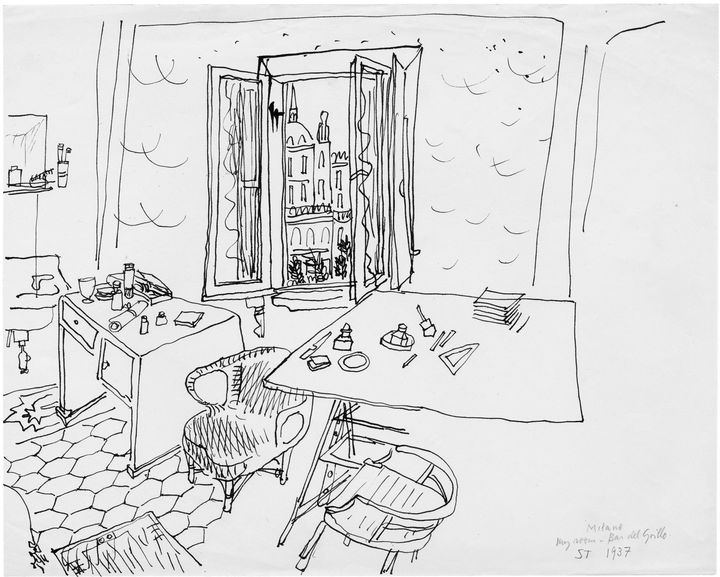
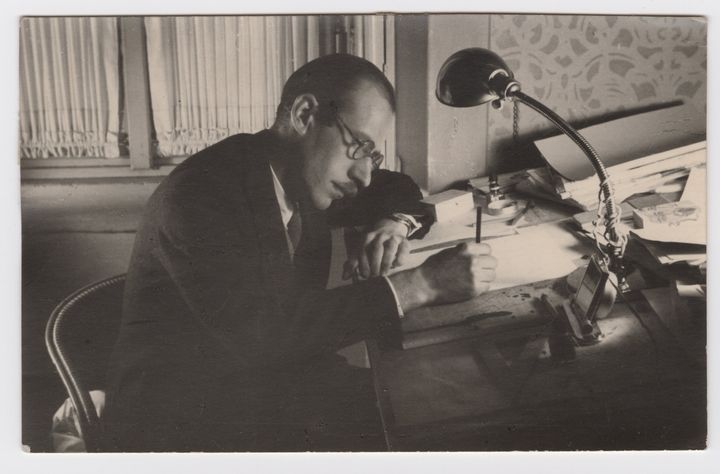
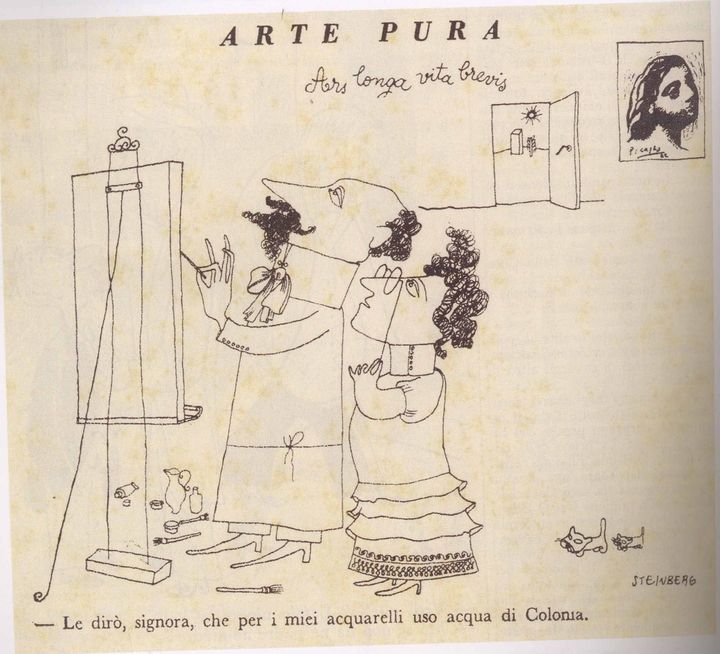
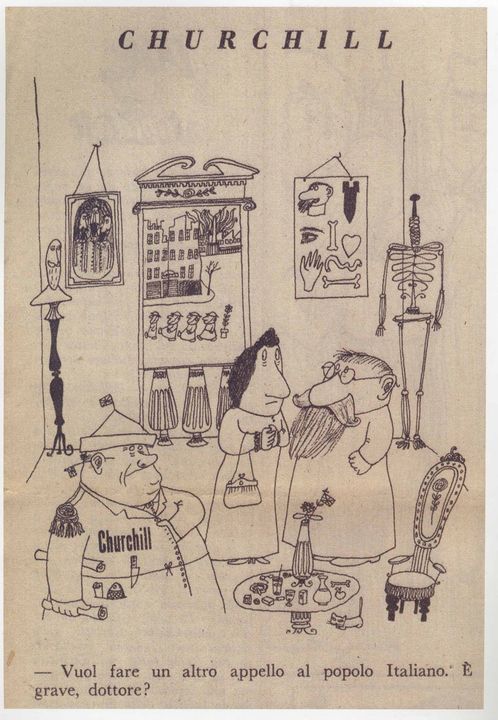
In some of Steinberg’s recollections, these first years in Milan have a nostalgic, bohemian tone: “I don’t recall if I even had plates or flatware. During my first year, at the pensione, I ate gigantic portions of rigatoni al sugo with sage twigs and all the bread you could eat, followed by goulash or stew drowned in red sauce, which you mopped up with the endless bread.”20 But in more candid reflections, he remembered 1934 and 1935 as unhappy years of loneliness and poverty. He had to wait until 1936 to have a good year, indeed an “excellent” one, a “paradise” year.21
In July 1936, the first issue of Bertoldo came out, a satirical humor newspaper published by Rizzoli that brought together some of the best young writers and artists of the time and was to have tremendous success.22 One of the paper’s writers, Carlo Manzoni, recalls that one day there appeared at the office
a young man with a blond mustache and glasses. He has a large portfolio under one arm. He puts the portfolio on the table and pulls out a paper with a drawing of a little man, a cartoon cloud exiting from his mouth: “I would like to illustrate a short story by [Giovanni] Mosca,” says the cloud. He pulls out more drawings and [Giovannino] Guareschi looks at them and places them aside. “O.K.” he says, “when Mosca arrives I will show them to him. Give me your address.” The young blond man says that he’s studying architecture, that he lives in the student residence, and that his name is Saul Steinberg.23
Steinberg, continues Manzoni, “is immediately taken in by the group of friends.” His first drawing appeared in the newspaper on October 27, 1936 (signed with the pseudonym “Xavier”).24 From that moment to the end of his official collaboration with the newspaper on March 19, 1938, Steinberg was to publish at least 204 cartoons in both Bertoldo and its supplement, Arcibertoldo (Fig. 4).25 The number he actually created, however, may have been higher if the figure of “250 or more a year” later cited by the artist is correct.26 The lonesome, cash-strapped student was no more: “For those years and for my conditions,” he said twenty-two years later,” we were always very well paid. I could make a living, I could eat and sleep, buy neckties….” 27 These were years of intense activity—twice-weekly newspaper deadlines, summer visits to Romania, and participation in a rich and lively intellectual ambiance.28 By the spring of 1938, Steinberg was a star in his field: he quit Bertoldo for its competitor, Settebello, published by Mondadori, where he was officially part of the editorial committee (comitato di redazione), working not only as an artist but as the intermediary in managerial matters between the newspaper’s two editors, Achille Campanile in Rome and Cesare Zavattini in Milan. He drew the ad for the renovated newspaper, and his first cartoon appeared on April 23.29
These years of “paradise” for Saul Steinberg were also the years of popular consensus in Italy for the Fascist regime, a consensus that peaked with the invasion and conquest of Ethiopia (October 1935-May 1936) and the consequent diplomatic isolation of Italy.30 The first issue of Bertoldo, July 14, 1936, carried on the front page a large cartoon against the League of Nations, and the second issue mocked the ousted emperor of Ethiopia, Haile Selassie. Likewise, the front page of the October 27, 1936 issue, where page 3 had Steinberg’s first cartoon, printed a huge reproduction of a telegram to Benito Mussolini: “44 MILLION ITALIANS EXPRESS THEIR GRATITUDE” (for the anniversary of the founding of the Fascist party). One should remember that all newspapers in Italy had to be authorized by the government and remained under the strict control of the propaganda authorities, which periodically sent out very detailed guidelines about what to stress and what to omit in order to conform to the official political line.31 Most often, the largest illustration on page 1 of Bertoldo was devoted to a political cartoon. Cartoons exploiting traditional anti-Semitic stereotypes also appeared, even before the enactment of the 1938 racial laws. Afterwards, however, such cartoons acquired a particular nastiness.32 Still, the newspaper and its authors managed to walk the thin line between compliance and satire and succeeded in sometimes mocking, albeit with highly cautious indirectness, the pomp and pretentiousness of some features of the Fascist regime. Over and over, for example, Bertoldo artists would poke fun at monuments, drawing horses riding humans or triumphal arches too small for the passage of a military procession. Also, writers mocked the rhetoric of some patriotic literature for boys and girls as well as the Fascist directive to Italianize all foreign words; this latter policy the Bertoldo editors pushed to the extreme, with hilarious results.
How Steinberg felt at this time about working in such a political environment is not publicly recorded, except in a discussion he had with Eugen Campus in Bucharest during the summer of 1937. As Campus later recalled, Steinberg said that artists living under a dictator such as Mussolini were free from the need for “demagoguery.” It was, Campus thought, as if Steinberg were advocating a sort of “truce” in the fight against Fascism, albeit as a “paradox.”33 Steinberg would privately admit that at that time he lived in a “political vacuum,” while “there were other people who saw better than I did – who participated, who understood” what was happening.34
A few years later, however, newly arrived in America, Steinberg had to explain to government officials how a young Jewish artist had lived happily and worked so successfully for newspapers in Fascist Italy—newspapers which, in 1941, even used some of his drawings (unsigned) in the propaganda war (Fig. 5)35 While his later refusal to make public his Bertoldo and Settebello cartoons had, he claimed, a cultural basis (their concern with “jokes” being implicity too lowbrow), the aversion may be also rooted in the fraught and nuanced politics of the 1930s—a complex situation unlikely to be understood by wartime American authorities or even by later generations. In 1942, impatiently awaiting a visa to enter the United States, Steinberg asked his cousin Henrietta Danson, who was in New York working on his behalf, not to mention “any my work [sic] in wartime Italy” to the authorities.36 By 1944, a politically correct spin—not to mention a promotion—had been put on his Italian newspaper activities. An officer in U.S. Naval Intelligence and the OSS for almost a year, he was introduced to new superiors as one who in Italy had been “editor and publisher of a well known paper violently opposed to Fascism.”37 As late as 1978, in the chronology of the Whitney Museum retrospective catalogue, he still felt it necessary to explain his employment in the 1930s: “In Fascist Italy, where the controlled press was predictable and extremely boring, the humor magazines were a way of knowing other aspects of life, which, by the nature of humor itself, seemed subversive.”38 Just two years later, recalling the pressure he put on Sandro Angelini to keep Angelini’s son Piervaleriano from publishing a thesis on the Bertoldo and Settebello work, he would privately use strong language that may have been provoked by more than mere aesthetics—“Who knows what dark horrors will surface?” “The horrible work…which uncovered my past... Blackmail!”39
Steinberg’s only other public response to his experience in Fascist Italy came three decades after his flight, in a series of memory drawings of Milan. Some of them have a pretense of objectivity, with the streets and the buildings of the city rendered in postcard-like fashion, urban perspectives that seem to capture the architectural style of the times. But in other Steinberg drawings that very style became a retrospective political statement. He consolidated the different modes of architectural modernism practiced in Italy between the wars into what he would mockingly call “Milanese Bauhaus”: perspectives are exaggerated, churches and apartment buildings are transformed into monstrous caricatures, all portholes, balconies, cantilevers, curved corners, and jutting verticals. “Milanese Bauhaus” often seasoned by Steinberg with Art Deco elements, symbolizes the whole of modernist architecture prevalent during his Italian years—Bauhaus, rationalism, Novecento, monumentalism.40 Such symbolic reductionism—a typical Steinbergian device—omitted the often complex and opposing realities of the Italian architectural scene of those years, not to mention the different artistic as well as political choices of some of the participants. Many architects coming of age in the 1920s, who wanted to transform an ossified cultural environment, did adhere to Fascism, hoping that its claim to revolution would help modernize Italian architecture. But as the regime evolved, academic design morphed into a rhetorical monumentalism that invaded Italian cities. Rationalist architecture managed to express some interesting – indeed, beautiful—examples, but was definitely on the losing side. By the end of the Fascist period, with the war ravaging the country and Nazi Germany ruling half of it, abetted by Mussolini’s republic in the North, some of these people would chose to fight against Fascism – and would die in the struggle.41
In the 1970s, however, Steinberg consolidated the stylistic realities of prewar Italian architecture (not to mention aesthetic links with similar movements in other countries) to create an architecture that stood for Fascism.
To stress his rejection of an architecture that he linked to a pompous and repressive political regime—which may not have been evident to his public in the 1970s—Steinberg populates the drawings with telling figures (Figs. 6, 7, 8): powerful soldiers marching, somber men of mystery (usually rubber-stamped), mustachioed men in black shirts and fez who leap to exchange Roman salutes and, in one drawing, goose-step in front of a building resembling the Palace of Justice in Milan, from which flies, for good measure, an Italian flag imprinted with the fasces.42
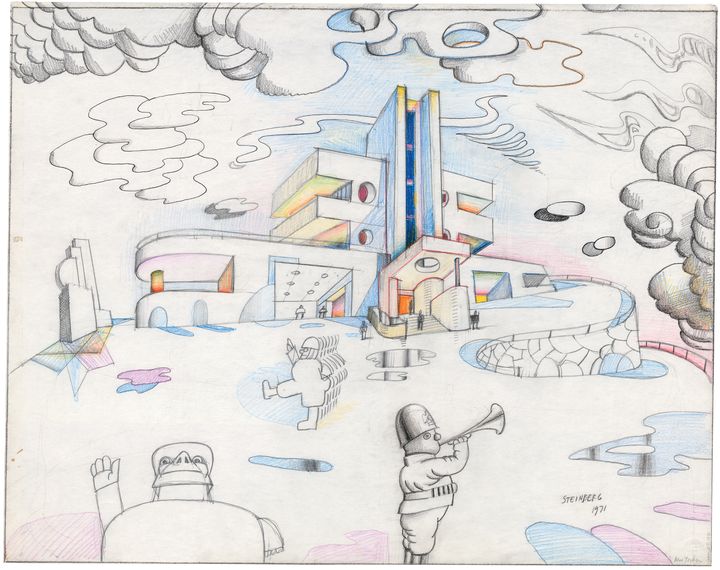
© The Saul Steinberg Foundation/Artists Rights Society (ARS) New York
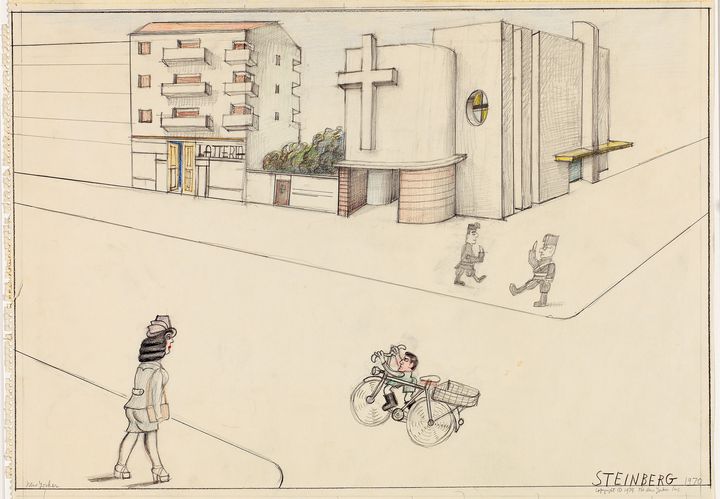
© The Saul Steinberg Foundation/Artists Rights Society (ARS) New York
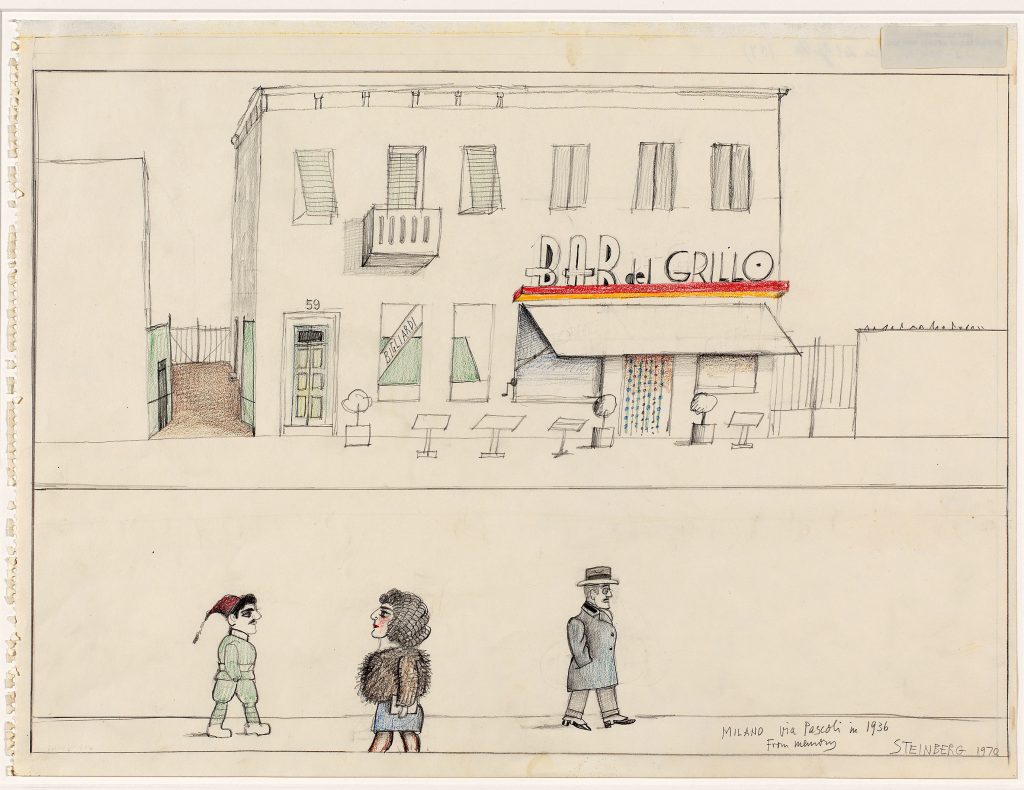
© The Saul Steinberg Foundation/Artists Rights Society (ARS) New York
BACK
Paradise Lost
The above paragraphs measure Steinberg’s prospective and retrospective response to Fascism. In real time, however, his situation was neither coolly theoretical, as he averred in 1937, nor politically activist, as his wartime statements and later images imply. His was most probably just the good life of a young student, who eventually managed to have money to spend and mingle with interesting intellectuals in a large European city, a city whose anti-Semitic currents were not yet as evident or as aggressive as those of the intra-war Bucharest he had escaped from. His future seemed Italian, and he even began using an Italian name: Paolo, instead of Saul.43 Whether this was also a conscious effort to underplay his Jewish roots, or just a way to feel and sound “like everyone else” is impossible to know. In either case, this good life would not last. With the imposition of racial laws in the middle of 1938, the world of “Steinberg Saul of Moritz—Romanian Jew” changed radically, and the “paradise” he found in Italy began to topple. “It was horrible,” he recalled two decades later, “you had the stupid society turning against you.”44
By the fall of 1938, foreign Jews were told to leave the country within six months. But, as in Steinberg’s case, refuge elsewhere was increasingly difficult to find. And Steinberg watched with growing panic as the situation of even Italian Jews (37,000 by the 1938 official census 45) deteriorated. After the legal emancipation of Jews in the mid-nineteenth century, the Italian Jewish community had become arguably one of the most assimilated in Europe—which must have given the young Romanian immigrant a welcome sense of belonging and reassurance when he arrived in 1933. All the more shocking, then, when the Mussolini regime began its racial discrimination and persecution campaign, a campaign that culminated in the Italian role in the Shoah. There were at the time Jews in the army, the judiciary, throughout the state administration, and in the Fascist party itself. Even though discriminatory measures against Jews had begun much earlier, and a racist campaign appeared in the press months before it became official policy, many Jews were caught by surprise when they found themselves demoted to second-class citizens, or worse.46 The Manifesto fascista della razza (“Fascist Manifesto on Race,” also known as the Manifesto degli scienziati razzisti or “Manifesto of Racist Scientists”), was published on July 14, 1938 in Il Giornale d’Italia (issue dated July 15) and then reprinted in the other major newspapers. It claimed a pseudo-scientific justification for the Aryan purity of Italians; Jews were not Italians because they had non-European racial elements.
The restrictive laws against Italian Jews came thick and fast. By June 1939 Jews in all professions were banned from working for non-Jewish clients. Of course, Steinberg, as a foreign Jew, could not work at all, since foreign Jews were under an expulsion order. But in fact he was already out of business. His last signed drawings had been published in the September 10, 1938 issue of Settebello, just a few days after the meeting of the Council of Ministers that resulted in the first anti-Semitic law.47
That summer, it seemed possible that Steinberg would not even be able to complete his studies. On August 6, a month before foreign Jews were ordered out, Giuseppe Bottai, the Minister of National Education, had closed university courses to all foreign Jewish students, “even those who had enrolled in previous years,” starting with the academic year 1938-39. This draconian rule, however, had diplomatic repercussions since it affected foreign citizens studying in Italy, and the Italian government feared similar restrictions on Italian students abroad. Thus, a month later, the Ministry of Foreign Affairs intervened, announcing that foreign Jewish students who had already begun their university studies and had been properly enrolled for the 1937-38 academic year could “carry on with their studies until they finished their degree.” It took until January 16, 1939 for the Ministry of National Education to issue an official clarification, but Steinberg had clearly gotten a reprieve: he could remain in Italy until he completed his degree, so long as he met one condition of the Ministry: that those behind in their coursework had to catch up within the academic year 1938-39.48
At this point, Steinberg was in the fifth year of a five-year program for a degree in architecture—and he had a lot of catching up to do. From the day his first drawing appeared on the pages of Bertoldo in October 1936, he had essentially stopped studying: from that moment through January 1939 he had managed to take only one of his seventeen scheduled exams, even though his student ID card shows stamps for six academic years, 1933-34 to 1938-39.49 1938-39 was, therefore, his first year beyond the official five-year program, and the last year in which the new rules allowed him to enroll at the Politecnico and thereby maintain his legal residence in Italy. From the moment the January 16 ruling was issued, Steinberg was in a race against time – to complete his degree and, at the same time, find some part of the world willing to welcome him.
Steinberg’s forced departure from the pages of Settebello after September 1938 left him seriously short of funds. Documentary confirmation of his impecunious state only begins in early 1939, but his circumstances in the previous months could not have been any different. His parents in Romania had been sending him money, but in the last couple of years he had depended on income from his cartoon work.50 Friends now occasionally lent him money, while others secured him work, most of it more closely tied to his studies in architecture.51 He was, he reported to his parents, “picking up some architecture or interior design jobs together with a colleague of mine,” although he didn’t like it.52 In a resumé compiled for the US Navy in 1945, he describes himself also as a “designer” and adds: “Occasionally I made designs for interior decorations.”53 Little was known about such activities until a few years ago, when Francesca Pellicciari found an original sketch by Steinberg in the archives of the celebrated graphic design-advertising agency Studio Boggeri (Fig. 9).54 Pellicciari, who published the sketch for the first time, makes the plausible suggestion that it must have been Erberto Carboni, a famous member of the agency, who brought Steinberg in. Steinberg later remembered him with gratitude: “A true aristocratic man, even in his appearance. During a rough time he gave me work.”55 Another one of these drawings, until now unpublished, can be found among the Steinberg papers at Yale: a clipping from the newspaper La Stampa, containing an advertisement for gas, “Dynamin, the Super Shell” (Fig. 10). It shows an urban street with a car stopped at an intersection. The print advertisement is signed at lower left with Carboni’s name, but attached to the clipping is a sketch on thin cardboard with a similar theme definitely executed in Steinberg’s hand (Fig. 11). The clipping is of the advertisement published in the June 24, 1939 issue of La Stampa (Fig. 12); Steinberg’s drawing was the basis for another ad published on August 5. Of the four other Dynamin ads signed by Carboni, most, if not all, are equally Steinbergian.56
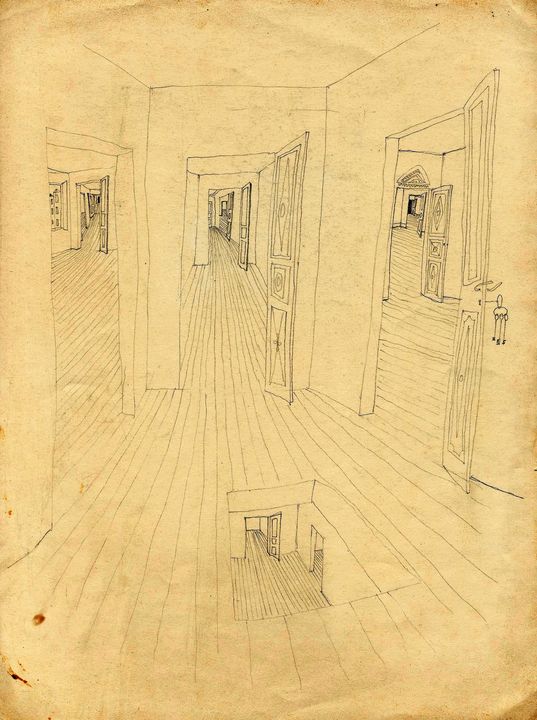
© The Saul Steinberg Foundation/Artists Rights Society (ARS) New York
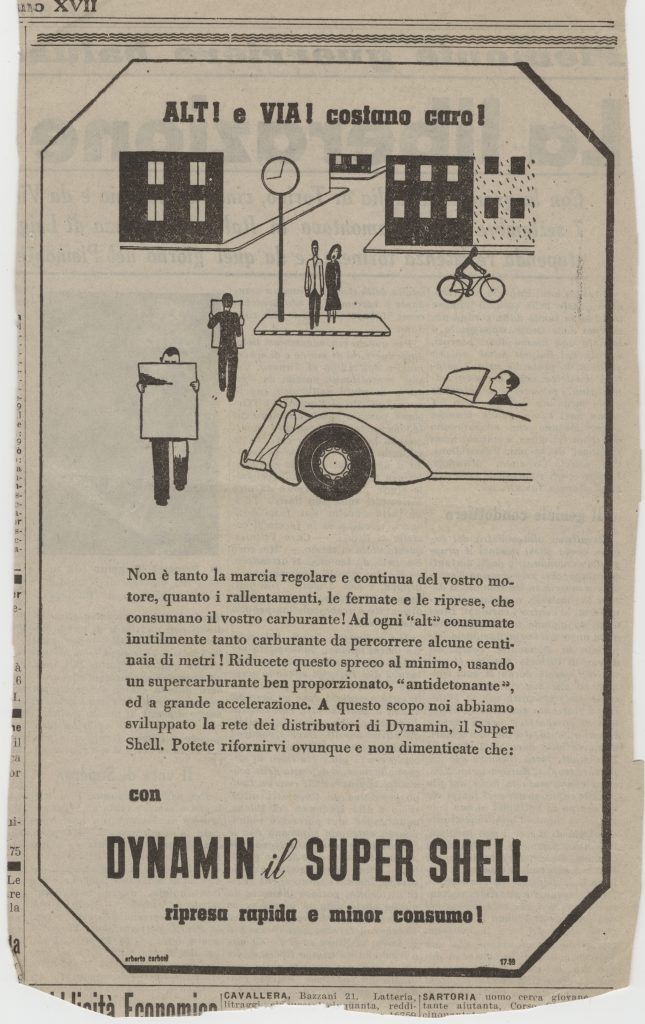
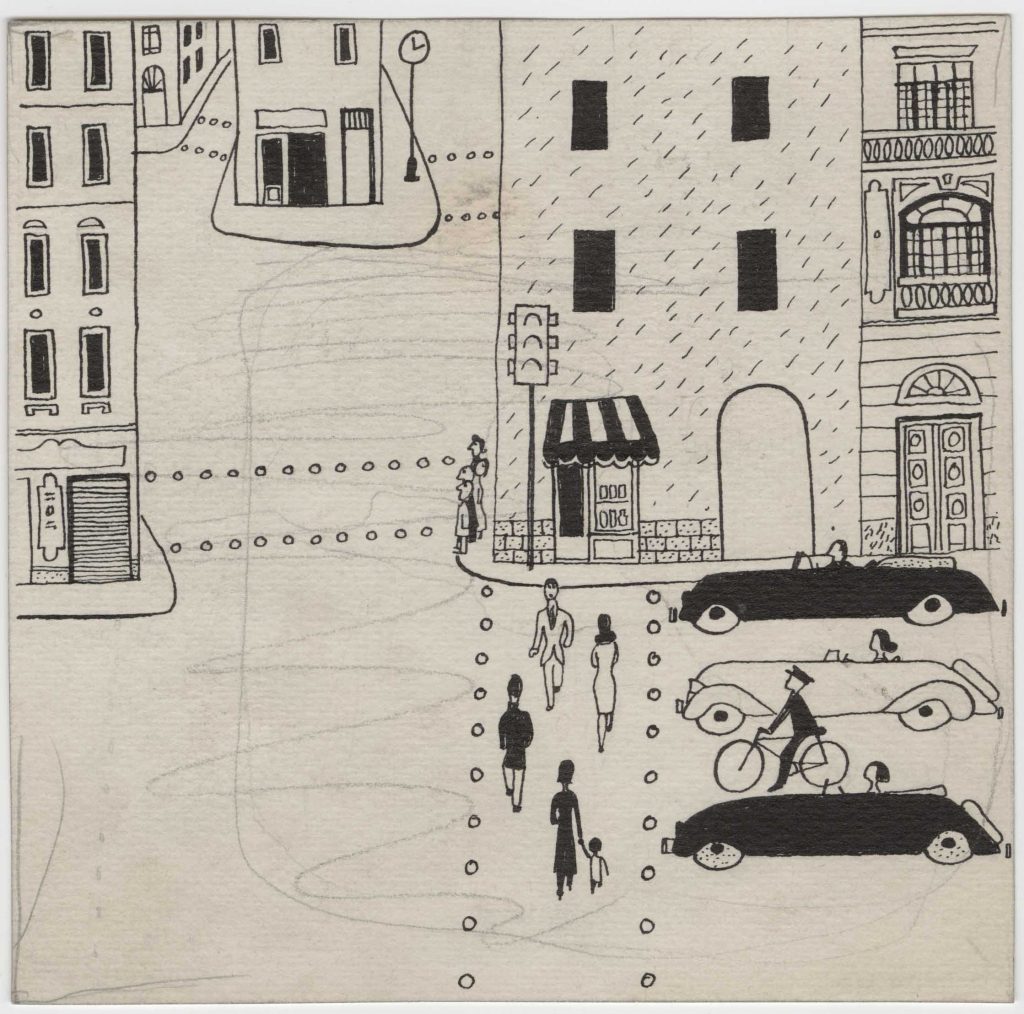
© The Saul Steinberg Foundation/Artists Rights Society (ARS) New York
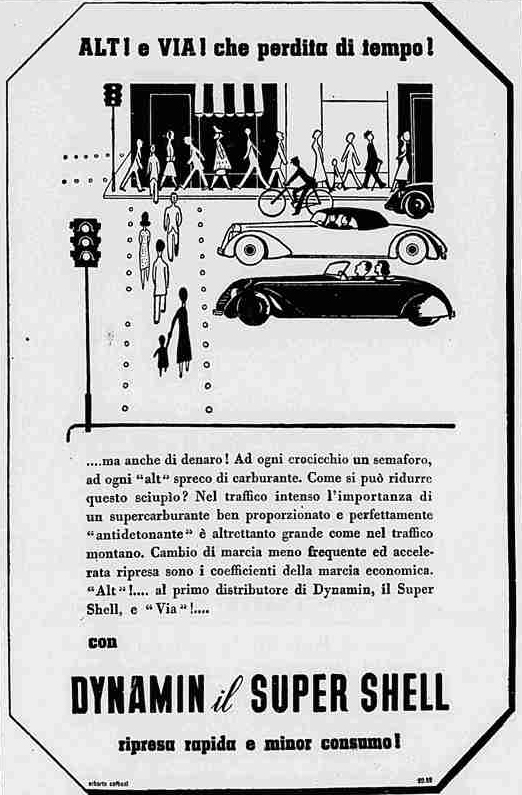
The journal recounts at least two other jobs. In one case, it clears up repeated references in his postwar correspondence to a “colored panel” made “for Latis,” possibly “for a house in Viareggio.”57 Vito Latis was an architect who found employment for Steinberg at this critical moment.58 The journal entry for May 7, 1941 (which briefly summarizes the events between January and April) informs us that shortly before being arrested by the police, Steinberg had finished a “panel for Rappallo” [sic] and, further on, that it has to do with “a panel for Sacerdoti [sic]. Drawing for a shutter door for a bar. Thanks to Lattis [sic].” The archives of the Latis Studio confirm the existence of a contract for furnishings in a Villa Sacerdotti in Rapallo (which Steinberg later misremembered as Viareggio, another seaside resort).59 The heir of the villa’s owner now possesses the painting Steinberg refers to (132 x 117 cm). It depicts a resort town (maybe Rapallo itself, in Liguria), seen from the sea, with bathers in the Mediterranean and conversational couples strolling the streets.60 In the same summation of May 7, 1941, Steinberg tells us that he made a “beautiful drawing with bottles and flowers for a bar for [Pietro] Chiesa (Fontana Arte).”61
Help also came from another professional source, Cesare Civita, briefly alluded to in the journal entry for May 20, 1940. Civita had been the co-director of the Mondadori periodicals (which published, among other magazines and newspapers, the Walt Disney cartoons in Italian), as well as a friend and collaborator of Alberto Mondadori. A Jew, he had fled Italy in 1938; a year later he was in New York, where he established himself as an illustrator’s agent.62 From across the Atlantic, he worked hard to get Steinberg published in the pages of American journals. And he succeeded: thanks to Civita’s advocacy, Steinberg’s work appeared in Harper’s Bazaar (March 15, 1940), Life (September 27, 1940), and Town & Country (October 1940), as well as in South American magazines.63
There was one other source of income from publications. Steinberg’s friends at Bertoldo and Settebello were able to resume publishing his cartoons in November 1940 by concealing his authorship, as Erberto Carboni had done—in this case, by printing them without signature (though readers of the newspapers no doubt recognized Steinberg’s hand). The journal speaks of such cartoons, which he was making up until the day before his arrest in April 1941. The entry for December 18, 1940, for example, notes: “five of my gags in an issue of Bertoldo”—the same entry where he announces, “I’m broke.”64
BACK
No Exit
Forced by the decree of the Ministry of Education to bring his coursework up to date during 1938-39, Steinberg crammed sixteen exams into one year and managed to graduate with the presentation of a theater project. The project has not turned up in the archives, but Vittorio Metz, Bertoldo’s co-editor, remembered that next to the building’s entry, Steinberg drew a stick figure with a lance in its hand, straddling a cow—“to indicate the proportions,” he claimed.65 It was March 4, 1940, probably the last possible thesis examination date for the academic year 1938-39, thus still on time according to the university rules established by the racial laws.
Graduation, however, meant that Steinberg’s legal residence in Italy was officially over, and he became more anxious than ever to get out. His diploma (Fig. 13) was inscribed to Saul Steinberg, “of the Hebrew race,” “printed,” he commented later, “in excellent taste, handsomely set in Bodoni, which rendered it even more sinister.”66 These words transformed the traditional language of such degrees—“for all legal purposes”—into a condemnation and a bureaucratic oxymoron: in the Italy of racial discrimination, the effect was to negate the diploma’s validity. It became a diploma for working in a profession that was not open to Steinberg. Forty years later, he would wax ironic about that piece of paper. Since he never worked as an architect, and since “Vittorio Emanuele III, King of Italy and Albania, Emperor of Ethiopia,” under whose power the degree was granted, no longer ruled these lands, nothing of the diploma remained valid except for the reference to the “Hebrew race.” So it was, in sum, a “diploma of Jewishness.”67
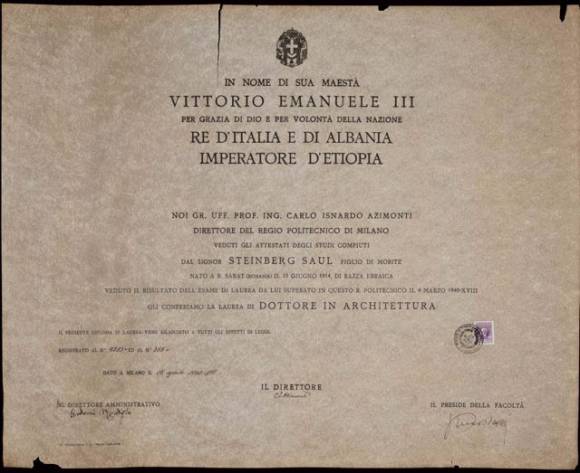
Accounts of Steinberg’s efforts to leave Italy have occasionally been hampered by fiction. The Italian journalist Indro Montanelli reports an encounter in this period with Steinberg and Ugo Stille, the late editor of Corriere della Sera. The place was the newsroom of Omnibus, the first modern illustrated magazine in Italy, edited by Leo Longanesi. With brilliant but mean-spirited phrasing, Montanelli recounts:
With [Stille], another Jewish boy began to poke his head into the newsroom occasionally, a refugee from Bucovina, and one destined to be talked about as the greatest caricaturist and cartoonist of the century: Steinberg. Together they had so much affection for Italy that they didn’t want to leave, not even when Italy joined the war as a German ally. “But what sort of Jews are these two?” yelled Longanesi, “Jews are, by definition, wanderers, and these don’t want to wander, not even if you kick their a…..!” Finally we succeeded in persuading them to seek American visas just in time to escape the Gestapo’s raids.68
Well told, like all of Montanelli’s stories, but untrue—at least with regard to Saul Steinberg.69 We know, in fact, that in late 1939, Steinberg had begun contacting relatives and friends in an attempt to leave Italy. Harry Steinberg, a paternal uncle who had emigrated to America in the 1890s, received a phone call from an Italian claiming he had news of Harry’s nephew, whom the uncle had last seen as a twelve-year-old boy. The man was Cesare Civita, who soon visited the Steinberg family in the Bronx with the news that he had been sent by Saul to ask their help in emigrating to America. Young Steinberg would find great success as an illustrator and cartoonist, he assured them.70 Civita’s visit mobilized Steinberg’s cousin Henrietta, her husband, Harold Danson, as well as other relatives in Colorado, all of whom worked, along with Civita, to obtain a visa for Saul and pay for his passage.71 From the moment Civita first contacted the Steinberg-Danson family, however, almost two years would pass before Saul managed to actually leave Italy, and more than year after that before he arrived in the United States.
In those two years, Steinberg was one of thousands of foreign Jews who found themselves stranded in Italy. In the autumn of 1938, about 3,100 of them were permitted to remain in the country, while about 8,800 were ordered to leave; some five to six thousand still managed to enter Italy from Germany or German-dominated countries on a “transit” or a temporary “tourist” visa. By June 1940, when Italy joined the war, about ten to eleven thousand had managed to leave, but close to 4,000 were left behind.72
Many of these Jews, along with Italian Jews deprived of citizenship by the racial laws, wanted to leave— for their own safety and in compliance with the laws — but they lacked the money or the papers to do so. And the outbreak of war in September 1939 made things all the more difficult, even if Italy had not yet joined the battle. Only those few who made the immigration quota for their country of birth were able to gain entry to the United States, while a handful of visas were obtained for some Latin American countries. In the meantime, international transportation — especially across the Atlantic — became more complicated. When Italy entered the war, on June 10, 1940, transatlantic passenger ships ceased departing from Italy, so instead of sailing from Genoa, it became necessary to pass through Portugal to reach a ship bound for America. But this indirect route required transit visas — visas that were sometimes dependant on other visas, which often expired before the whole journey was completed. Furthermore, the available boat passages were few and expensive.73
Many Jews were aided by DELASEM, the Delegation for the Assistance of Jewish Emigrants (Delegazione per l’assistenza agli emigranti ebrei), founded in December 1939, with headquarters in Genoa and offices throughout Italy. It was an official organization created with government authorization, under the auspices of the Union of Italian Jewish Communities (then “Unione delle comunità israelitiche italiane,” now “Unione delle comunità ebraiche italiane”). DELASEM’s aim was to give foreign Jews in Italy financial and administrative assistance with the emigration process.74 In the first seven months of its existence, DELASEM aided approximately 9,000 Jews—residents or those in transit—and about 2,000 managed to leave with its help, the majority of them on Italian ships. However, when Italy declared war in June 1940, there were still about 3,800 foreign Jews in Italy, among them Saul Steinberg.75
Steinberg apparently did without financial aid from DELASEM.76 But the organization lent crucial assistance at the very end of his internment in June 1941, which suggests that he had been in touch with them earlier about his paperwork. The practical matters of dealing with consulates and the Italian authorities could be frustrating and complex, all the more so after Steinberg’s graduation from the Politecnico, which marked the end of his legal residence. Now the young Romanian Jew anticipated being stopped and expelled from one moment to the next: “In the spring of 1940, shortly before Italy entered the war, I expected to be arrested.”77 And surely the prospect of being forced back to that “fucking nation,” where the anti-Semitic measures were doubling daily, and which was soon to be marshalling its troops with Nazi Germany, added fear to bureaucratic tangles. So much so that Steinberg began to regret having stayed in Italy through graduation, instead of leaving before the war “when everything was simple. Now,” he added, “it’s too late, it’s impossible to leave and I don’t know if the degree of architecture will be useful to me in the present or future situation.”78 An attempt in April 1940 to get a visa for the United States failed. So did an attempt to get to Portugal in May, when the authorities denied him a tourist visa because he was a Romanian Jew.79 Thus, in the weeks preceding and following Italy’s declaration of war, Steinberg’s American supporters came up with the idea of having him emigrate to Santo Domingo, bringing him one step closer to the United States. He tried unsuccessfully to obtain a visa himself from the Dominican consulate in Genoa. On June 7, the Dominican Republic Settlement Association, writing to one of those supporters about the required documents for a visa, observed that the matter could wind up being “purely academic, as it is questionable whether there will be any boats out of Italy from now on.”80 Even Cesare Civita feared that it was “too late now to get Saul out of Italy,” but he insisted on trying to get him a visa: “perhaps he might find some way we can not foresee to reach San Domingo or Ecuador.”81 The paperwork went ahead, and on July 8 the Association telegrammed Henrietta Danson that the visa for Saul was ready at the Dominican Legation in Milan.82
Steinberg’s Dominican visa is dated July 26, 1940, seven weeks after Italy entered the war against France and England. It must have been a precious document to him because it promised deliverance from an alarming consequence of the declaration of war, the internment of civilians deemed dangerous to the Italian regime: subjects of enemy countries capable of carrying arms, those suspected of espionage, or with questionable political affiliations.83 People were arrested, brought to a police station or a jail, and then transferred to the so-called “places of free internment” or to the campi di concentramento (internment camps), organized and run by the Ministry of the Interior.84 “Free internment” meant that the detainee was deported to a small village and forced to live within its boundaries, subject to such constraints as curfews and roll calls. The internment camps were collective places of confinement, with the internees allowed only limited contact with the population. Most of the camps were situated in southern Italy or in isolated Central Italian regions, distant from possible war fronts and prying eyes. The physical facilities differed widely—villas, apartment houses, convents, even theaters had been taken over and adapted for the purpose; in other cases, fenced-in barracks were built, such as the camp of Ferramonti di Tarsia in Calabria, which eventually held over 2,000 prisoners (see below).
Italian Jews as a whole were not considered candidates for internment, but they came to represent 11.7% of all Italian internees, about ten times the proportion of Italian Jews to the general population: much harsher criteria were clearly used to assess their supposed risk.85 Foreign Jews like Steinberg presented a complicated problem, since they had been directed to leave the country but lacked exit papers. Although the policy of the Ministry of the Interior was to facilitate the departure of foreign Jews, the breakdown in international communications after Italy’s entrance into the war radically changed the situation. A DELASEM report to the Ministry, dated July 22, 1940, announced that there were 150 Jews with visas for the United States, 50 with visas for Santo Domingo (within four days, Steinberg’s would arrive), and a few others with visas for Palestine or Shanghai—but no one knew how to get them out of Italy.86 War had no sooner been declared than the government decided to ease the worsening logjam by subjecting foreign Jews to internment as well, justifying the practice with a dose of racism. On June 15, the chief of police ordered the arrest of Jews “from countries with racial policies” and of stateless persons between the ages of eighteen and sixty: “These so-called undesirable elements,” he wrote in a telegram to the prefects and the police commissioner in Rome, “filled with hate toward totalitarian regimes, capable of any deleterious action, must be immediately removed from circulation in defense of the State and public order.” “Hungarian and Romanian Jews,” he specified further on, “must be”—in the euphemistic language of the Ministry—“removed from the Kingdom.”87
The beginning of the round-ups shattered both Jews and their organizations.88 “In the last few days the arrests spread like wildfire,” wrote Gastone Polacco, a DELASEM official in Milan to headquarters in Genoa on June 20, 1940. On July 22, he described a recent roundup in Milan:
There were about 100 arrests made, more than half of these [people who] voluntarily presented themselves [to the police] on the basis of lists given to us [by the authorities]. We have managed to have jail time reduced to the minimum possible, so that now those arrested are sent to their destinations usually on the second night following the arrest.
We were unable to do anything about the manner in which the prisoners are accompanied: however, it appears to us that as soon as they board the trains, they are freed of their chains and it seems that the chains are not put back on….
By August 12, Polacco reported that “our situation is to be considered absolutely terrifying and could give way to the most tragic and unthinkable consequences, as we must provide, practically forever, for the upkeep of nearly nine hundred persons, without any arrangements of any kind.” 89
Saul Steinberg certainly witnessed the fate befalling fellow foreign Jews in his own city, and it shattered the illusion that he had found a real home in Italy. “I didn’t want to accept the reality, the betrayal—the way dearest Italy turned into Romania, hellish homeland.”90 But this was written more than half a century later, and in a private letter. His public descriptions of life in post-1938 Italy were recast as amusing anecdotes. In the 1970s, he breezily recounted how he managed to escape the classic arrest hour, between 6 and 7 am, by waking up a little before 6, riding around Milan on a bicycle borrowed from Giovanni Guareschi, and then returning to bed at 7. But one morning, just as he was about to go out, the youngest of the four sisters who ran the Bar del Grillo, where he was staying, warned him that the police had arrived. He managed to flee by means of a secondary exit; returning at 8 am, he was “welcomed like a hero.”
They told me that one of the policemen, a real Sherlock Holmes, had felt the bed and said, “It’s still warm.
The policemen were poor devils, southerners who did this job without taking any interest in it. But their laziness, the fact that the organization did not function well, resulted in an inefficiency that would then be converted into a lack of injustice.”91
The stereotypical observation about the good-humored inefficiency of Italian bureaucracy sidesteps the repressive force that the Ministry of the Interior managed to exert with studied souplesse, as it tried, and to a certain extent succeeded, in forcing its victims to collaborate in the arrest process.
BACK
An Aborted Escape
With his Dominican visa in hand, Steinberg now had to find a way to get to Lisbon, where he had passage booked on a boat to New York. A ticket awaited him. DELASEM had proposed to the Ministry that refugees heading for America board their vessels in Lisbon, and that they get to the Portuguese capital on ships bound for Spain, or fly via Barcelona “using the services of the Ala Littoria.”92 The proposal was accepted, but Spanish ships no longer provided real passenger service, and Ala Littoria flew to Barcelona only once a week; furthermore, the flights were expensive, and the few available seats were often reserved for diplomats and official delegations. Between June 10 and November 30, 1940, only 202 people managed to leave Italy by these means.93 But Saul Steinberg was one of those who made it out, if only briefly.
On August 26, Cesare Civita sent him a telegram: “Intervention by State Department at the American Consulate should authorize it to grant transit visa for the United States; even if you do not have it by Tuesday, depart nevertheless for Lisbon. Civita”94—which Steinberg did, since there is no US visa in his passport, only a Portuguese transit visa stamped on August 29, and a Spanish one dated September 3.95 On Friday, September 6, he managed to leave on an airplane for Lisbon, via Barcelona-Madrid.96 But at the Lisbon airport something dramatic happened. Portuguese authorities denied him entrance and sent him back to Italy the next day on the very same plane. This was to remain a catastrophic event in Saul Steinberg’s life. The diary published here begins on December 6 with the statement: “3 months since my return from Lisbon,” and a little later Christmas is described as “a day as sad as the 6 and 7 of September.” Decades after, he still spoke of September 7 as a “most dramatic disaster—my black Friday.”97 In the autobiographical notes prepared for his 1978 retrospective at the Whitney Museum, there is not the slightest mention of the Lisbon disaster. Nor can it be found in Steinberg’s narration in Reflections and Shadows, where he merely notes that in the quest for visas to leave the country, “the only one missing was the Italian one, which they wouldn’t issue without my physical presence, proof of having obeyed the law.”98 The missing Italian “visa”, however, probably refers to his second flight from Italy several months later. In the summer of 1940, it would have been unthinkable for a foreign Jew to board an airplane from Rome without an official exit permit.
The real reason for the September disaster in Lisbon has only recently come to light in the form of Portuguese documents, which tell a story Steinberg probably never knew. When he had applied for a tourist visa in May, the Portuguese Foreign Ministry denied it, fearing that the country would become a dumping ground for “undesirable” Romanian Jews.99 As a result of the Foreign Ministry’s letter to the secret police (PVDE, a powerful body during the autocratic regime of António de Oliveira Salazar), Steinberg was put on an unwanted list. To the “great surprise” of the border police at the Sintra airport near Lisbon, the artist showed up on September 6, carrying a valid passport and a valid visa signed by the Portuguese honorary consul in Milan, Giuseppe Agenore Magno, three months after the first refusal. The police went by the book and denied him entry, while the consul – one of a number of Portuguese diplomats who helped Jews finding safe havens – was disciplined for his action.100 The fact that Steinberg was supposed to board a ship bound for New York but did not have an American transit visa may have reinforced decision of the police, who would have been unwilling to let in another refugee lacking the papers to leave. This is probably what he himself thought had happened, since two years later, just before his actual arrival in the United States, Civita’s secretary had to reassure him: “As to your documents, please believe that they are now in perfect order, and that there is not the slightest danger that the events of Lisbon will again take place.”101
BACK
On the Paperwork Trail
September 1940: Saul Steinberg was back in Milan, without a job, without permission to stay in Italy and, most important, aware that he could be arrested and interned at any moment or forcibly sent back to the “primitive” and detested Romania, where a change of regime – for the worst – had just taken place. In Bucharest on September 6 and 7, the very days when Steinberg was at the Lisbon airport, General Ion Antonescu and the extreme right-wing group known as the Iron Guard staged a coup that ousted King Carol II and set up the so-called “National Legionnaire State” along Fascist-Nazi lines, and the Italian press was awash with coverage. To make things even more clear to the young Romanian Jew in Italy, the Conducator Antonescu explained in an interview to an Italian newspaper that extreme anti-Semitism was now official policy:
I will solve the Jewish problem (…) by gradually substituting Jews with Legionnaires who will ready themselves in the meanwhile. Most Jewish property will be expropriated and compensated. Jews who arrived in the country after 1913 (…) will be sent away as soon as possible, even if they have become Romanian citizens, while the others – I repeat – will be gradually replaced.102
Steinberg spent this period living at home in the apartment above the Bar del Grillo and in the houses of friends, in particular the studio of his colleagues Aldo Buzzi and Luciano Pozzo on Via dell’Annunciata.103 As we have seen, he managed to work a little under the table for newspapers, did some advertising assignments and commissions for architect colleagues, and seems to have received financial help from his friends and acquaintances. His romantic life was filled with the woman whose name punctuates the journal, Ada or, in the affectionate diminutive, Adina (Fig. 14). Ada Cassola probably met Steinberg in 1937. Six years older than he, she was married (and later went by her husband’s name, Ongari) and a Catholic.104 Their relationship was intense, an admixture, as the frequent journal entries show, of longing and occasional annoyance.105
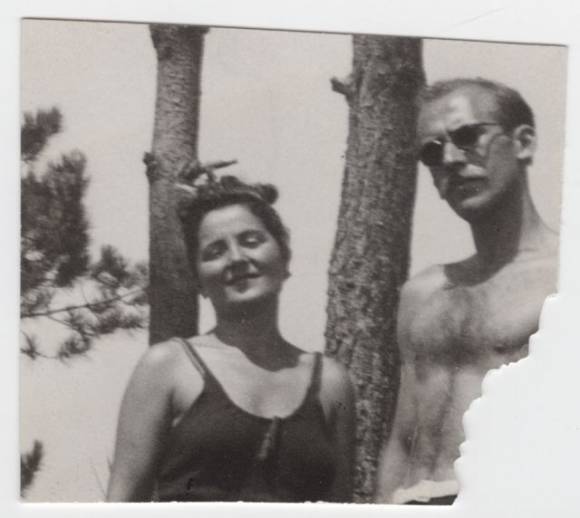
The main task for Steinberg in the fall of 1940 was to renew now-expired visas so that he could leave once more for Lisbon. He seems to have been aiming for a late December departure, since his journal for December 8 records that the USS Siboney, which made trips between Lisbon and New York, was scheduled to sail in twelve days. On November 17 he got a “Transit Certificate” stamp by the US Consul in Milan; on the 27th , having somehow cleared his position with the authorities in Lisbon, he managed to receive another Portuguese transit visa, this time from the Consul in Genoa.106 But his Romanian passport, reissued the previous year, was to expire two days later, on November 29, 1940, and the Romanian Legation in Rome would not renew it, “without giving any reason therefore,” according to Steinberg. What he may not have known was that the Legionnaire regime, as part of its anti-Semitic policy, was now targeting Romanian Jews even abroad: “passport renewals were denied for a wide range of reasons (not having paid military taxes, for instance), and return to Romania became more difficult.”107 Discovering that Steinberg’s passport was no longer valid, the Spanish consulate cancelled a transit visa it had just granted, as he explains in the December 6, 1940 journal entry; the newly issued visa on p. 12 of his passport bears a large blue X and a red-penciled “Anulado.” He had to start all over again: “I had a Rumanian passport, it was no good at all, it was like an indictment.”108
In the meantime, however, the situation in Portugal had become chaotic. At the end of October, a famous American journalist arriving in Lisbon found the city to be “an international whirlpool into which were swept from every direction, people of all nationalities, races, colors and tongues, none wishing to stay, but all forced to remain long days, weeks, and sometimes months awaiting transportation.”109 There were refugees who lacked valid visas for their countries of destination as well as visa-holders who could not find a berth on a ship. So many people were flocking to Portugal that the authorities cut off entry into the country even for those with legitimate transit visas until February 1941.110
Steinberg’s journal for these later months of 1940 tells of his comings and goings between Milan, Rome, and Genoa to renew visas and permits, and of an uneasy relationship with the American Consulate. In the December 30 journal entry, the Vice Consul had been “tightlipped” when Steinberg applied for a transit visa earlier in the month, but on January 16, the US Consulate issued a “Affidavit of Travel,” with a photograph and biographical details that somehow could be used as a corroborating identification with his now-expired passport. But the journal entries also speak of films he has seen (Stagecoach, Piccolo mondo antico, Jamaica Inn), of visits to galleries, of air raids, of the bombs on the Porta Ticinese neighborhood, and of his hopes to work again for Settebello; he writes of his disappointments as well, and of his clearly complex relationship with Adina. We learn, from the journal and elsewhere, of his friends’ efforts to make the police authorities go easy on him. In an unpublished passage of the dictated memoirs that became Reflections and Shadows, Steinberg describes a “pact with the police headquarters” set up “through Mondadori and Mondadori’s acquaintances,” ensuring that he be treated well at the moment of his arrest. “I believe,” he adds, “a certain Captain Vernetti was helpful to me.”111 Vernetti appears also in the journal entry for January 8, 1941 as the bearer of “extensions” and of both good and bad news; then, on April 24 and 27, as the police officer who arrested him and brought him to prison.
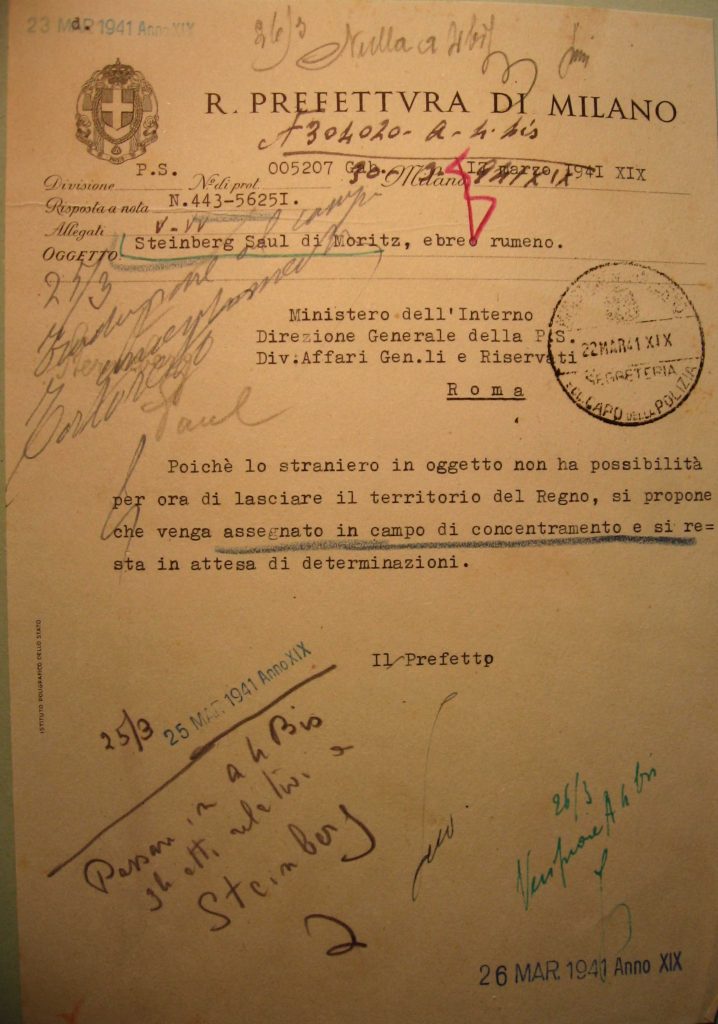
In fact, between hiding out and moments of accord with the local police, Steinberg was ignored by the central authorities until February 1941. What then happened to him can be reconstructed from the documents in the “Steinberg Saul di Moritz” folder still in the Archivio Centrale dello Stato, Rome. On February 21, a telegram from the Prefect of Milan informs the Ministry about this young Jew who, “having been warned to leave the Kingdom,” now declares that he cannot do so since his passport has expired; and even though he has a travel affidavit for the United States, he has not yet obtained new transit visas for Spain and Portugal. This conundrum seems to create some kind of bureaucratic embarrassment, and the Prefect asks Rome for “directives”; in reply, the Ministry asks the Prefect to “formulate concrete proposals.”112 Two weeks later, the Prefect proposes that, as “the foreigner in question is unable to leave the Kingdom,” he should be “assigned to a concentration [internment] camp.”113 This last memo from the Prefect is covered with annotations in various hands (Fig. 15). Scrawled across the top is “nulla a debito”—there was “nothing against the subject.” Another, dated March 25: “Transfer to concentration camp Tortoreto.” The actual order is found in a memo dated March 31, though it was not immediately enforced.114 Steinberg, in the meantime (as he explains in the journal entry of May 7), spent from late February until April 16 “awaiting Rome’s decision”; he may, sometime in April, have been taken by the police for a short time and then released (“April 16, already out,” he notes).115 Another ten days passed before Steinberg, who was hastening to complete work projects, showed up at the police station. He turned himself in on April 27, was taken to San Vittore, Milan’s central prison, and from there to the camp of Tortoreto in the province of Teramo.
BACK
Internment
“As a child, I dreamed of being the Count of Montecristo, of writing my diary with my own blood. When I found myself in prison I understood I had become an interesting subject for a novelist,” even amidst the “sadness that was permanent.”116 In sum, a romantic “grand adventure” in the San Vittore prison, which Steinberg described in his journal entry of April 28 (in ordinary fountain pen ink) with punctilious curiosity: the chamberpot and the arrival of the scopino, the prisoner assigned to clean it; playing cards with a deck made from tobacco papers, the red ink drawn in blood; the schedule for prisoner checks and the “enormous trafficking” of cigarettes and news. And all this illustrated with drawings. The sketches of the three-man cell 111, second wing, along with views down corridors and through barred windows, are brief and informative (Fig. 16), the first in a series of graphic notations Steinberg would make in the following months about his new places of residence.
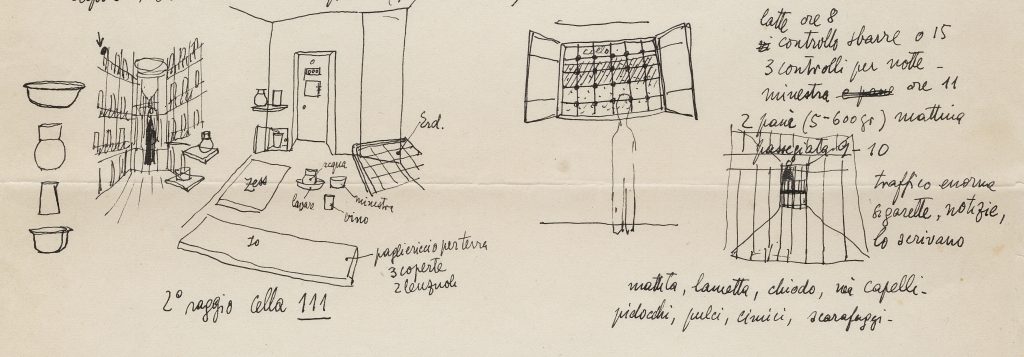
© The Saul Steinberg Foundation/Artists Rights Society (ARS) New York
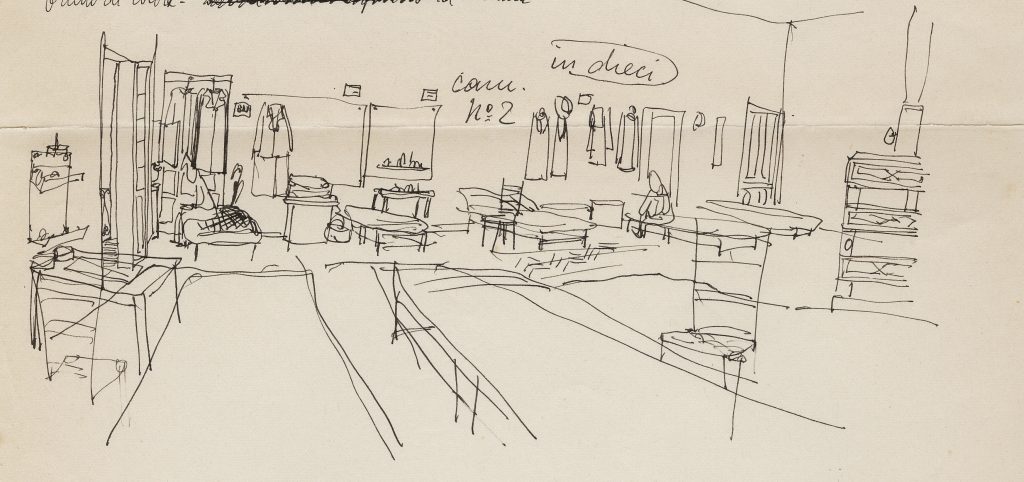
© The Saul Steinberg Foundation/Artists Rights Society (ARS) New York
His verbal and graphic inventory of prison life dodges the real horrors of the San Vittore jail, where he spent four days, though some prisoners remained there for several weeks before being transferred. They were treated like the common criminals with whom they lived, an experience described as “the most harsh and humiliating of the entire adventure.”117
On July 2, 1940, the Ministry sent a memo to police headquarters, urging the officials to transfer the detainees to the internment camps as soon as possible.118 Prisoners incarcerated in San Vittore were not informed of their final destination. Steinberg’s biggest fear, noted in his journal on April 30, was that he would be sent to “Ferramonte,” that is, Ferramonti di Tarsia, the large camp in the province of Cosenza (Calabria), about 150 miles south of Naples.119 The only purpose-built camp, it was located in a marginal and depressed area, with malaria a constant menace, as the Milanese Jewish community had just learned from a first-hand observer.120
Steinberg was not shipped to Ferramonti; on May 1, accompanied by two policemen, he was taken on a train headed for Tortoreto, a small Adriatic town in the Abruzzi. In Reflections and Shadows, he recounts his journey in tones that personalize geography: “During that wonderful trip I saw perilous mountains for the first time, with the train going ever so slowly along the edge of the abyss, which was precisely my situation.”121 In the journal entry for May 1, however, there are no adventurous voyages described, only a simple itinerary Milan-Bologna-Rimini-Ancona, along a route that is actually very flat.122 He spent the night at the Ancona station, where he managed to send his parents a postcard, written in an upbeat tone, which says nothing about his internment: “I’m constantly on the road in my attempt to leave. I hope I’ll succeed soon. I’m well and hope to give you good news. In any case, even if I don’t succeed right away, I’ll console myself with the idea that sooner or later I’ll succeed.”123 He arrived in Tortoreto, his journal tells us, at 10:30 in the morning on May 2: “I see the sea, beautiful.”
In the township of Tortoreto, there were two different camps: one in the center of Tortoreto Alto, a village up in the hills; and one in Tortoreto Stazione, to which Steinberg was headed, located in the area around the railroad station, which after the war became known as Alba Adriatica.124 The camp, he tells us in Reflections and Shadows,
was a villa from which you could see the sea, but you weren’t allowed to go to it. The camp was small, with perhaps fifty internees: a few Jews, White Russians, gypsies, stateless persons, refugees, being held there in a fairly makeshift and human fashion as compared with the other camps. I was lucky.125
The “villa” was the Villa Tonelli, not too far from the station (Figs. 18, 23). A two-story building with a large garden in front, a living room, kitchen, ten large rooms on the first floor, ten on the second, and nine other habitable rooms; the police authorities deemed it suitable for interning seventy-five people. It was not fenced in, and the prisoners were allowed, under escort, to walk about for an hour a day.126 Officially, contact between prisoners and the residents was prohibited, but Elena Zanoni, then a girl living in the villa next door, tells of strolling with her friends one day, when they became aware of a new arrival, a “romantic young man who fascinated all the girls on account of his good looks.” Some quick detective work revealed he answered to the name of Saul Steinberg. He was so remarkable and noticeable that the few weeks Steinberg spent in Tortoreto were enough for “the town girls” to use his first name, in the Italianized version of “Paolo.”127
Life went on in the form of daily roll calls, attempts to fill the empty hours, and the search for food (Fig. 17). Prisoners with no money were given a daily stipend of 6.5 lire, which was raised to 8 lire a little before Steinberg’s arrival—a raise for which the prisoners sent a thank-you note to Mussolini, illustrated by the architect Walter Frankl, a fellow inmate (Fig. 18).128 These funds went to the common mess, where, Steinberg recalled, “there was quite a traffic in bread: fresh bread, dry bread, all kinds of bread. Grass and herbs, a bit of onion, were added to make bread soup, bread pies.”129 Playing music was permitted, even if it had to be somewhat muted, and violinist-prisoners entertained their companions.
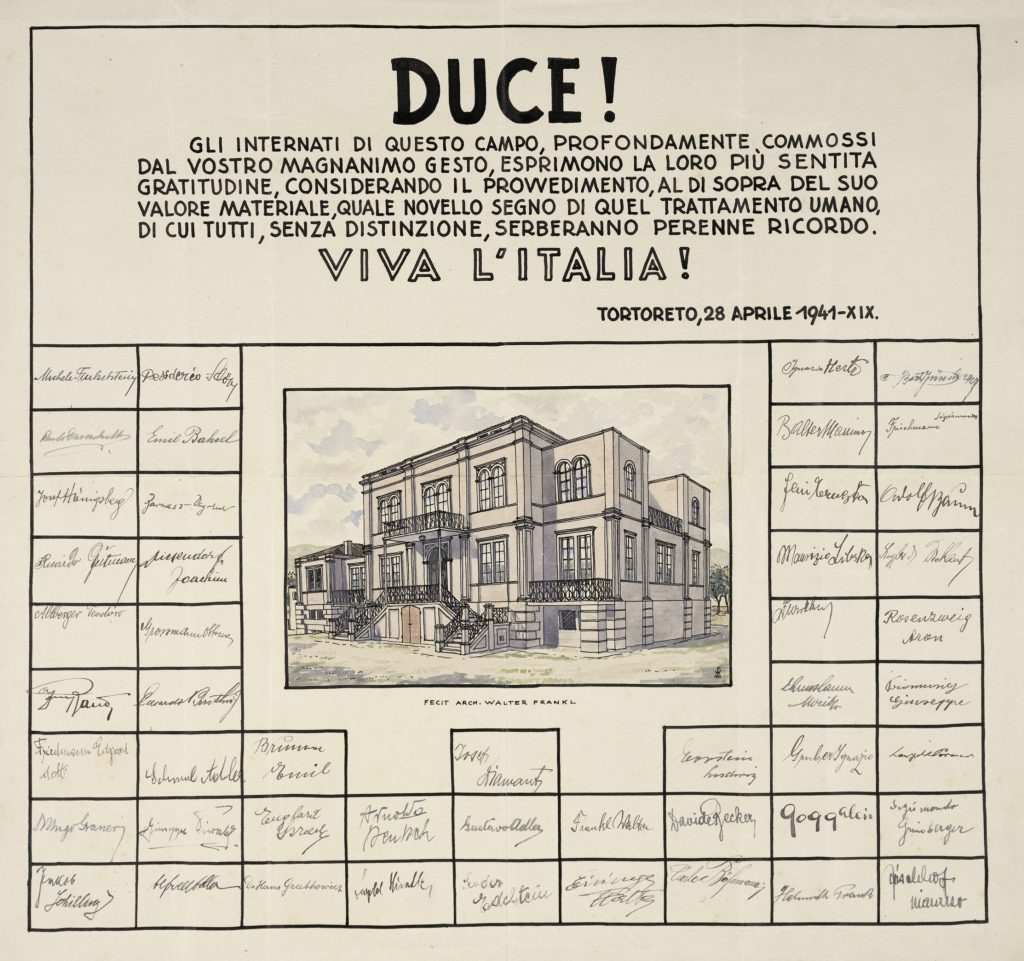
At night we had curfew, and these thirty people gathered together in the dining room with the lights off, and there was one man there who was a good violinist, he had a fiddle with him, and he played the fiddle with a… mute, and played very quietly so that the guard wouldn’t wake up, and in the dark played… he played some Beethoven, some classical music. It was beautiful. It was the most beautiful… I still have goose pimples about that music.130
The violinist was probably Alois Gogg, an Austrian who would eventually be freed along with Steinberg, and, like him, sail from Lisbon to New York.131
Steinberg spent his time drawing, painting, writing, receiving letters, and handling the paperwork necessary to secure his missing visas.132 At the time of his internment, he had a new reservation on a ship scheduled to embark from Lisbon on June 20. He therefore asked for authorization to leave Tortoreto to complete his paperwork: on May 3, to go to the Portuguese Consulate in Genoa for a transit visa; on May 21, to go to Milan to revalidate his American transit visa, which the American Consulate had demanded he do in person.133 Such requests were not unusual, given that government policy was to help foreign Jews leave Italy.134 In Steinberg’s case, the Prefect of Genoa advised against allowing him to travel to the city, while a few days later the Ministry agreed to let him travel to Milan.135 All these efforts, however, became unnecessary, thanks to the intervention of DELASEM. On June 4, the DELASEM office in Rome wrote to the Ministry requesting an immediate release for Steinberg so that he could catch a plane in Rome on June 12 in order to make his scheduled departure from Lisbon on June 20. Permission was granted on June 6, and Steinberg boarded a train for Rome two days later with Alois Gogg.136 Writing to his friend a few months later from Santo Domingo, Steinberg would remember the train journey from Tortoreto, the excitement, the tension, even the people on board chanting prayers for family members who were fighting at the front: “It was an ugly period,” he said, “which, remembering it now, becomes beautiful, especially for me, since I was going to Milan to see my girlfriend.”137 More than fifty years later, he reminisced to Aldo Buzzi:
How lucky I was to be saved… I took a night train from Rome, seated, with all the perils, police, documents. Arrived safely in Milan, spent the day with Ada, while Natalina scolded me: What poor things you have in your suitcase, ingegnere! She had seen my worn-out socks etc. in the wardrobe. At night I returned to Rome, a crowded train, nameless hotel, on Via dei Chiavari, I think, in the Ghetto. Saved from minute to minute by a miracle. The only thing remaining in my mind is the beautiful maid in the hotel, going up and down the narrow staircase.138
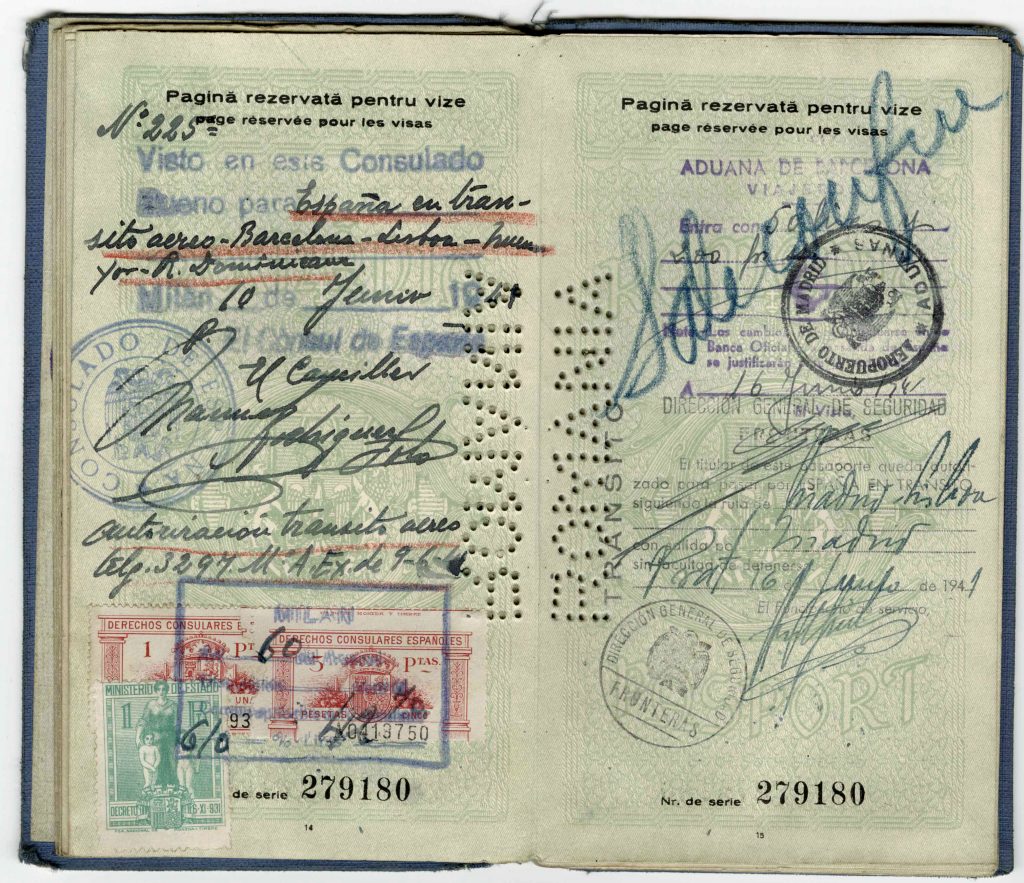
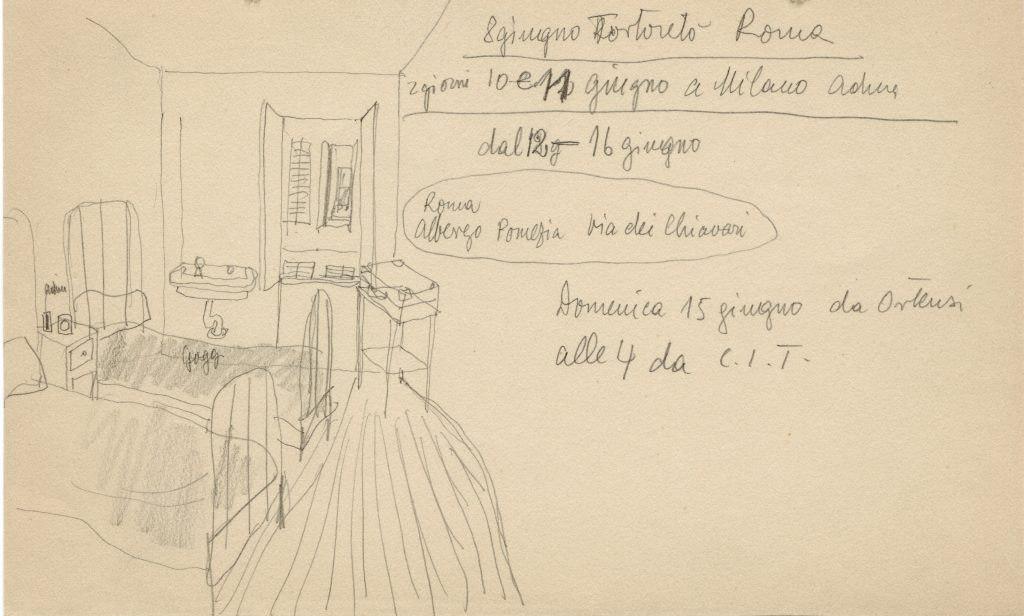
© The Saul Steinberg Foundation/Artists Rights Society (ARS) New York
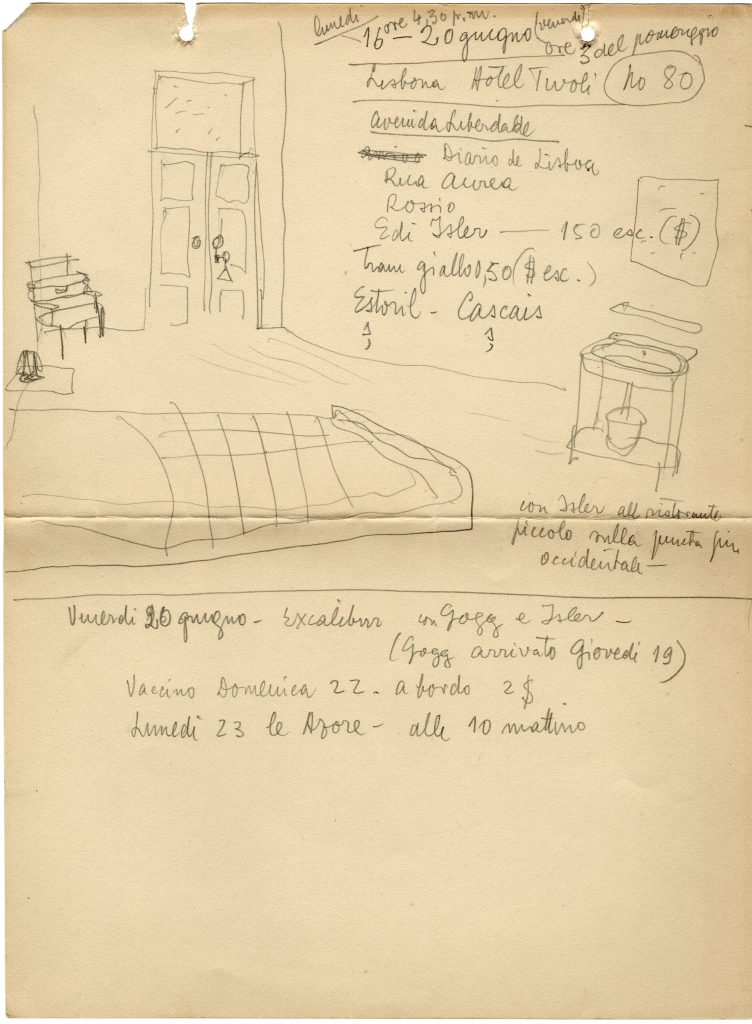
© The Saul Steinberg Foundation/Artists Rights Society (ARS) New York
Between Milan and Rome, Steinberg collected the last of his missing documents (Fig. 19).139 He stayed in Rome at the Hotel Pomezia in via dei Chiavari (Fig. 20) from June 12 until June 16, when he once more got on an Ala Littoria flight for Barcelona-Madrid-Lisbon.140 This time, the Portugese authorities allowed him entry. Arriving in Lisbon, he stayed at the Hotel Tivoli (Fig. 21), and on June 20, he boarded the S.S. Excalibur, a ship of the American Export Lines. Ten days later, the boat arrived in New York Harbor, but Steinberg could not get permission to disembark and was forced to remain on Ellis Island.141 On July 5, he was once again at sea, now bound for Ciudad Trujillo, as Santo Domingo was then known. There he spent one more year, working and hoping for an American visa, until the summer of 1942, when he finally flew to Miami and boarded a bus to New York. After two years of frustration and fear, he had done it. And he was one of the lucky ones: between December 1, 1940 and October 15, 1941, only 210 other foreign Jews managed to leave Italy.142
In the United States, Steinberg began to work for the American government, and in February 1943 he received both US citizenship and a commission in the Naval Reserve. Assigned to the intelligence services, he was sent to China, India, Algeria, and finally, in mid-1944, to Italy, having literally gone around the world from east to west in less than three years.143 But that is another story, which interests us only because in Bari in 1944, wearing an American officer’s uniform, Steinberg ran into a fellow detainee from Tortoreto who was selling stamps from a street stand. The man, without recognizing Steinberg, said that he had survived because, with the fall of Mussolini on July 25, 1943, he had gone south, while others had traveled north, straight into Nazi hands.144
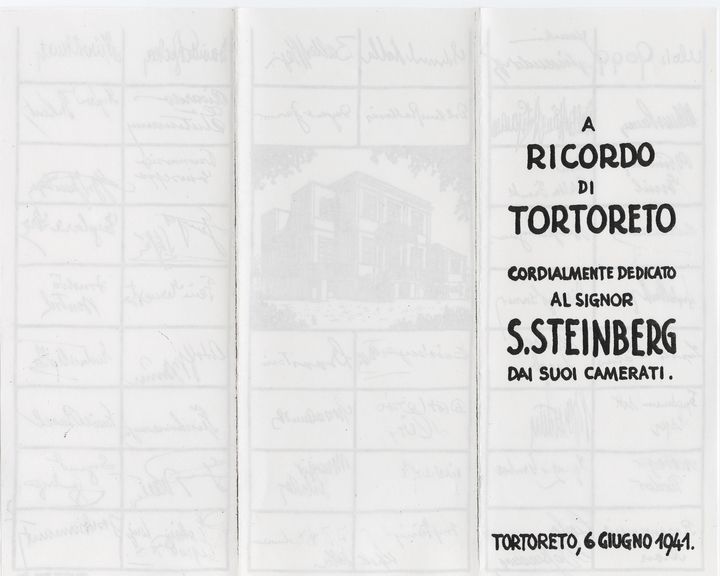
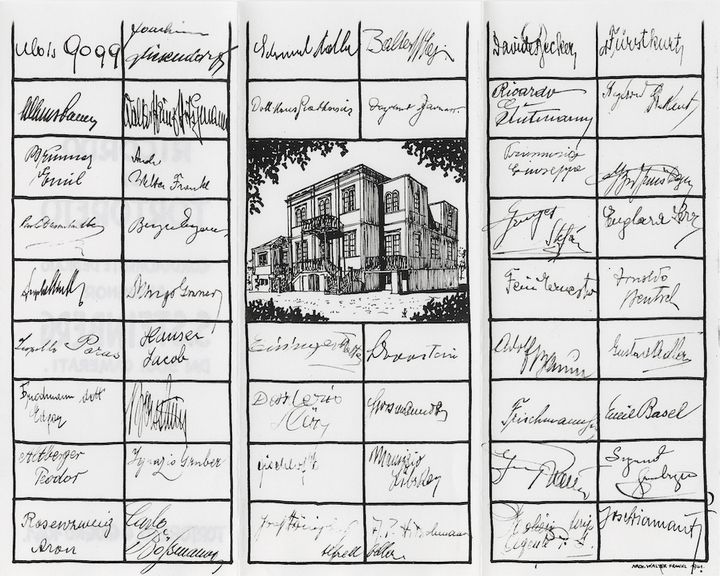
The night before his departure from Tortoreto, Steinberg’s companions had made a dinner in his honor, offered him a “special supper,” with “lots of bread and the sweetest tea,”145 and a folded farewell pamphlet with a dedication: “A souvenir of Tortoreto. Cordially dedicated to Mr. S. Steinberg from his comrades” (Figs. 22, 23). Inside was a drawing of the Villa Tonelli, surrounded by the signatures of those destined to remain.146 Thirty years later, Steinberg looked at the pamphlet once more:
We are all there, I am in the title. And the signatures seem to be from the XIX century, signatures that give an idea of the importance, of the dignity of man, to the very last one. These poor men. I hope that many of them were saved on July 25.147
The signature on the drawing of the villa is that of the Viennese architect Walter Frankl, the same man who had created the thank you note to Mussolini for having raised their daily stipend, “a new sign of that human treatment, of which everyone, without exception, will remember forever” (see Fig. 18).148 That “forever” did not last long. In October 1941, as a “family reunion” measure, Frankl was transferred to the village of Castelnuovo Garfagnana (northern Tuscany), so that he could live with his wife, Elisabeth. But at the end of 1943 the region was taken over by the Nazis. On December 6, with the other Jews who were living as “free internees” in Castelnuovo, the Frankls were sent to a nearby camp, then transferred to Milan’s San Vittore prison. On January 30, 1944, they were on the transport that left a special underground section of Milan’s central railway station bound for Auschwitz. Neither would ever come back.149
BACK
Saul Steinberg’s Journal, December 1940-June 1941
Between the end of 1940 and the summer of 1942, Saul Steinberg kept an occasional journal, in Italian, on loose sheets of paper. Often they were only hurried notes, or after the fact reconstructions that followed long periods of silence. Along with the written entries, he sometimes added sketches of the places he was describing. The journal is among Steinberg’s papers at YCAL.150 Here we publish the first part of the journal, which covers the period between December 6, 1940 and June 20, 1941.
The more or less continuous narration is interrupted at the end of December 1940 and picks up again on April 27, 1941 with a brief interlude dated “Tortoreto, May 7,” referring to events during the intervening period. Steinberg seems to have returned to the journal once he had arrived at Tortoreto, picking up the thread again from his arrest on Sunday, April 27; afterwards, on May 7, he wanted to fill in the interim of four months using the available space on the bottom of December’s page, and a little of the reverse of that same sheet of paper.
The dates are highlighted in boldface and a line separates one page from the other. Editorial notes are in brackets.
Milan, December 6, 1940 [Originally 7, corrected to 6]
3 months since the return from Lisbon – Today – as if to celebrate the date, the Spanish consul cancelled the visa already issued because [my] passport [was] expired. Accusation of bad faith. Enough.
I spoke with [Giovanni] Guareschi about gags, even drawings.
Evening at [Giovanni] Mosca’s, where I lost 100 lire playing cards. Today I couldn’t see Adina – After much time, in the afternoon, I went to the cinema (Ombre Rosse [Stagecoach, by John Ford]) . Always falling lower −
I received from Albisola 3 rather ugly ceramics.151
I notice that more and more often Friday brings me bad luck. Friday departure for Rome, Friday departure for Lisbon. Today, pitch-black day, Friday.
God will help me get through these years
added May 7, 1941 (Tort[oreto])
Friday May 2, arrive in Tortoreto.
Saturday, December 7
Yesterday naturally was the 6th. The 6th and Friday. It all [the bad luck of the day] still holds and even more so.
Afternoon with Adina at home. She told me small things that she shouldn’t have told me because they’re inconsequential.
I am anxious right now and as always when something eludes me my desire for it grows stronger.
Evening at [Giovanni] Mosca’s [a Bertoldo colleague] – I had already sent him some little cubes of wood, painted, which he liked.
I appear to be courting him because I am interested but I do it without this idea in mind.
Fiorio and his wife were also there. Tonight I wondered whether Fiorio was the one who looked at Adina on the tram.
They talked about a baby who put a bean in his nose and the bean sprouted roots and spread through the inside of the nose, way up.
I finished reading I Promessi Sposi which is a great and fine book 152 —
Still haven’t received anything from home.
Sunday, December 8
The “Siboney” leaves in 12 days.153 Got up at noon. Malaise. In the afternoon I tried to make a few gags.
[Aldo] Buzzi came. He doesn’t think I ought to work with them [“da loro,” i.e., people, though it is not clear who]. I would not treat a friend this way.
I feel more and more empty in the head.
We have beautiful, moonlit nights, but there are no more alarms [air-raid sirens].
Thursday, December 12
Yesterday and today were good days. I will see later if it they really are good.
So: Monday Adina was here in the afternoon.
Then I went to [Pietro] Chiesa154 to finish the drawing then, following a phone call with the Panamanian Consul, went at 10 in the evening to Rome.
I arrived at 8 in the morning and went to the Romanian Legation without any result. Spent 3 hours in the waiting room.
I saw in passing two magnificent gates, in a beautiful green, next to the Teatro Marcello near the gate of the Ghetto. I returned late on Tuesday evening.
Then on Wednesday, telephoning Mosca, I learned that [Angelo] Rizzoli bought Il Settebello and that they are well-disposed toward me.
In fact, in the afternoon, going to [the office of] the newspaper, Andrea [Rizzoli] said, in an absent-minded way, speaking to others, that his father agreed and that I will begin on the first of January.
I was very happy, it felt like the good [old] times. Today I saw Adina a little. We met and had tea downtown.
Thursday, [December] 12
Toward evening, I saw, with Buzzi, the exhibition of Birolli and Carrà.155 Hmmm…
Crosignani left.
Monday received a letter from home. I have to answer. Harry wrote them an ugly version about the Lisbon business.156 I also have to write to Ciucu157 I’m happy. Tomorrow I will go to the newspaper with “Candide” for Carletto [Manzoni] and 4 packs of tarot cards that I took from Clerici.158
Tomorrow is a bad day, I’ll be careful. It’s Friday the 13th.
Friday, December 20 [he recaps the previous week]
Friday the 13th nothing happened to me.
Saturday [the 14th] with Adina, and Sunday too.
Tuesday [the 17th] at Mosca’s, evening.
Wednesday [the 18th] at 2 in the morning alarms. In a shelter with everyone on our floor. Saw some beautiful tracer bullets [from anti-aircraft fire]. Bombs at the Porta Ticinese. Fighting with Adina because yesterday evening she was with her girlfriends on the 1st floor.
Today I should have left from Lisbon on the Siboney – I was at the US Consulate, which will write to the Romanian Legation in Rome. If it doesn’t get results, they’ll get a Travel Affidavit for me.
I’m broke – I get up late these days. I am reading The Life of Benvenuto Cellini − Buongiardino from the architecture school brought me Town & Country with one of my drawings159 – I made a painting for [Cesare] Civita using an earth brown—tempera.
Five of my gags in an issue of Bertoldo.160
Monday, December 23 [he recaps the previous days]
Saturday [the 21st] evening, alarm, nothing happened. They went over Fiume and Venice
Had a fight with Adina in the evening.
Buzzi was at my place.
Sunday [the 22nd] I got up late and in the afternoon Giorgio shot pictures of me and other “artistic” ones.
In the evening I called Adina 2 hours in a row but the phone was always busy. Evening alarm.
Mama writes me from home that she would like to come to me. She’s afraid because I will leave.
Today, Monday, I was at Bertoldo in the late morning and toward the evening. [Mario] Brancacci161 was there and others from Ecco [another magazine].
Disgusting! At midday with Mosca in the Galleria to buy a book.
In the afternoon, Adina came to see me. I made her talk.
I’ve done nothing else, not even work.
I’m an idiot, a real idiot. Even spent this evening chattering with Natalina etc.162 Telling them about my business.
Now I go to bed. I will pray to God.
Monday, December 30, 1940
Nothing special this week except Sunday: Sunday, December 29, 1940.
Yesterday evening I made the first 2 drawings for Bertoldo, useless and ridiculous work = It will last for one more issue and then that’s it. Then yesterday I spent the whole day with Adina – I want to sate myself.
Saturday evening [the 28th] with Adina to see Jamaica Inn with Laughton at the Impero [Alfred Hitchcock’s Jamaica Inn, 1939.]
Wednesday Christmas. Tuesday evening at Mosca’s to eat – [Gilberto] Loverso, game with Milly, Zenoni, Fiorio, Mangeri, Achille163—
Today Archangeli [sic] tells me that we need a telegram for Lisbon. This morning at the US Consulate where [William L.] Krieg [American Vice Consul] is very tightlipped – Sad day, like the 6th and 7th of September. Today I sent the ticket to Genoa.
These days usually get up at 10. Cappuccino and brioche, read Corriere [della Sera] and [La] Stampa and buy, depending on the day, Marc’Aurelio, Bertoldo, Oggi (these 3 now free) Guerino, [Il] Travaso, Domenica [del] Corriere. I eat at Il Grillo midday and evenings, spaghetti, cutlets and fruit now cost 10 lire – In the evening I buy L’Ambrosiano and La Stampa Sera.164 – I played billiards a lot until last week.
Tomorrow is New Year’s Day—For the first time I write 1941. I hope to be able to go on to see in 42 whether 41 has been good or bad for me --
1940 for sure was a bad year, the worst so far -- Still, I got my degree, learned a little English, enough to understand a headline, but it’s still good, [and] I published some stuff in America.
Certainly 1941 will begin badly: January 8. The day when school begins after vacation.
[At this point, having arrived in Tortoreto, he summarizes the events of January-April]
May 7, 1941 Tortoreto. January 8 I got other postponements with Vernetti.165 Always blowing hot and cold every 8-10 days – Then an interval between the end of February to April 16 awaiting decisions from Rome – April 16 I was already out. Thursday [April] 24, presented myself with Vernetti after a painful week in which I made the panel for Rapallo.
Got two more days – Sunday, April 27 went to S. Vittore166 – Saturday the 26th with Adina to see “Piccolo mondo antico”167 and then to eat at Il Grillo
Did everything in a hurry. Saturday the 26th had Adina for the last time—Dear girl.
I worked for Bertoldo up until the last issue [for him], published in the week of April 16. Then [Carlo] Manzoni continues by imitating my drawing. Also made a cartoon for an issue of Settebello.
Recently, 2 cartoons for Tempo.168 Gags for : Guerino, Tempo, Bert[oldo] and Settebello.
Continuation [on the back of the same page]
Made a painting for Radaelli (and 3 already published drawings framed with colored glass).
Panel for Sacerdot[t]i. Drawing for a shutter door for a bar. Thanks to Lattis.169
Sold 5 cartoni170 at the newspaper: Guareschi, Manzoni, Andrea, Parini, Loverso.
Beautiful drawing with bottles and flowers for piece of bar furniture Chiesa (Fontana Arte).171
Milan [top left side, in a box]
Sunday April 27 [originally “Thursday,” corrected to “Sunday”]. I go with Vernetti to S. Fedele172 —10 in the morning—11 o’clock with a policeman to S. Vittore (by taxi).
Until 9 in the evening in a security room with 36 others – I sleep on the ground floor with three others in the cell. Three: one [there] because of a fine – two thieves to be interned in the islands.
Monday, April 28 – transferred to the 2nd floor, 2nd wing with Zessevich and Erdös. The first a Soviet Russian – inside for 56 days. The other a Hungarian for 50 days. Both under suspicion waiting for [their] repatriation or liberation. Playing cards with tobacco papers, bread crumbs and soup, white paper on top, all drawn with a copying pencil. The red [ink] made with blood. String to hold up the trousers. Lots of tobacco. I learn to play Scopa [Italian card game]. Newspapers: Gazzetta dello Sport, Guerino, Domenica [del Corriere], Corriere [dei] piccoli.173 Marmalade, chocolate, dried figs, walnuts, beer, wine, cheese, bread, cigarettes, only Swedish matches, soap, warm milk. Scoppino (cleaner of chamber pots).174
[Steinberg’s four drawings of San Vittore, Fig. 16, appear at this point, running horizontally across the page. Inscriptions:]
Second drawing from left, captioned “2nd wing, cell 111.” On the long mattress is written “Io” (me), and described, to the right, as “straw mattress on floor, 3 blankets, 2 sheets.” The mattress above is identified as that of “Zess[evich],” the gridded one to the right as that of “Erd[ös].” The objects on the floor contain, clockwise from lower right, “wine,” “washing bowl,” “water,” and “soup.”
Drawing at right: “Milk at 8, inspection of cell bars at 3pm, 3 checks per night – soup at 11, 2 loaves of bread (500-600 gr.) in the morning walk 9-10, lots of traffic, cigarettes, news, the scrivano [prisoner-scribe], pencil, razorblade, nail, in the hair - lice, fleas, bedbugs, cockroaches.”
Wednesday, April 30, 11 am, am advised that departure will be tomorrow. Great fear of Ferramonte.175
Thursday, May 1, downstairs at 9. Shave. In a taxi with two policemen. Telephone Adina. She already knows, dear girl, she was at Ferraro’s. Station, Buzzi with the suitcases. Adina sees me suddenly, does a little jump. Gray overcoat, black dress with her aunt’s brooch. Donizetti in mourning: death of his mother.176 Truly feel for him. Saw her just a few days ago, at their house. Don. gives me medicines.
I kiss Adina lightly, wet mouth, she cries – I won’t see her any more– Dear Adina --
Sicilian officers– Change at Bologna, then Rimini, where we eat at the dopolavoro.177Arrive Ancona at midnight. Sleep in the station until 6:30 in the morning. Arrive Tortoreto 10:30.
Tortoreto [in a box on the left margin] I see the sea, beautiful – Friday (again), May 2, I begin at Tortoreto
Saturday, May 3 I write to Buzzi, to the committee, [send a ] telegr[am to the] committee.
Sunday, May 4 I write Buzzi a letter
Monday, [May] 5 Can’t go out today because of the fair– I look at a photogr[aph of] Adina
Tuesday May 6 - Receive a letter from Adina. She writes “Tortoretto.” She was in Genoa for me, dear girl. I answer a bit uneasily. Dear Adina.
Read “Huck Finn” by Mark Twain. Tom Sawyer takes off his hat as if taking the lid off a box of sleepy butterflies.
Then [Hugh] Walpole’s “The Joyful Delaneys.”178 Try to buy a little table and chair to work. I clean the oily brushes, with turpentine. I begin to smoke Popolari.179
Wednesday, May 7 Unpredictable weather. Wind. I’m beginning to get used to things. I do everything with great calm, in no hurry. So do all the people in town.
Thursday, [May] 8 Receive letters from Adina and Buzzi – Dear Adina.
Friday, [May] 9 It rains, I work on the little painting. It’s one week I’m at Tortoreto.
Saturday, May 10 Today “10 mai” I finished the little painting. Still life on a table in the foreground, in the background, rooms, families, the usual things. The self-portrait on the table, not bad – all a little messy and confusing in color – Adina –
[The drawing of the dormitory at Tortoreto, Fig. 17, fills the rest of this page. It is headed “Room No. 2,” and circled at right, “ten of us.”]
Tortoreto. Friday, May 23 No answer from Rome – Few hopes of leaving. Yesterday went to Tortoreto Alto – Dentist – Met Levitan, a Russian, nice guy. Anghel Dumitru from Galati.
Adina, always thinking of her – At nights, I put my head under the covers, start to think. I greet her, Hi, Adina – Adina sends me a 50 lire money order perhaps from her own money. Poor dear Adina, I love her very much.
I painted a horizontal picture with lots of things.180 Made a good tree from life.
Saturday [May] 24 Adina writes me the same day. She regretted having written me badly a few hours before. That’s good, dear.
Received [a letter] from Buzzi. Says that a telegram arrived at Il Grillo from Lisbon.
Received [a letter] yesterday from home, from mama. I had bad forebodings – I received a package with paper and cardboards.
Wednesday, May 28 Receive letter number 1 from Adina.
Yesterday I sent 2 temperas to Buzzi. I dream that I return home –No news about the departure. If I don’t leave, I’ll die of heartbreak. Toothache.
Thursday, May 29. 5 months since December 29. Passed quickly. Tomorrow, Friday the 30th, I will receive bad news for sure.
Friday, [May] 30 Instead, Delasem sends a telegram that the Portuguese visa was received. Very happy. All of a sudden, I change the way I do things. Too much. Fear that I will have many disappointments and will have to eat my words of joy – Nothing from Adina.
Thursday, June 5 –We’ve made it - await Friday the 6th, tomorrow, with terror.
Friday, [June] 6 8 o’clock, beautiful day – woke up early
10 o’clock, perhaps 2 more hours. Ate cherries. Sent postcard to Adina with a view of the market date underlined --
10 minutes to 12
6 PM – nothing has happened so far - At noon Delasem Rome writes that [the time] until the 20th is very limited. They have to have the plane ticket and I messed things up. The day still isn’t over– Something bad may have happened today and I will learn about it tomorrow or the day after --
Saturday, [June] 7 I’m working, calmer. 10 o’clock—[Alois] Gogg calls me from the street181 – We leave together tomorrow. The “commissario” calls me –Tomorrow you leave for Rome – Dear Adina
[At the bottom of the page, probably added afterwards:]
Ciudad Trujillo Thursday, July 24. I arrived here Sunday July 13—Dear Adina
[Drawing of his room at the Hotel Pomezia, Rome, Fig. 20. Inscriptions:]
June 8 Tortoreto—Rome
2 days June 10 and 11 in Milan Adina.
From June 12 -16
Rome Albergo Pomezia Via dei Chiavari
Sunday, June 15 at [Mario] Ortensi’s
at 4 [went] to C.I.T.182
On the far bed: “Gogg”; the photo on the nighttable is labeled “Adina”
[Drawing of his room in the Hotel Tivoli, Lisbon, Fig. 21. Inscriptions, top to bottom:]
Monday, June 16-20 (4:30 pm) – 20 (Friday) 3pm
Lisbona Hotel Tivoli [in circle:] no 80. 3:00 in the afternoon.
Avenida Liberdade
Diary of Lisbon
Rua Aurea
Rossio
Edi Isler---------------150 esc. ($)
Yellow tram 0,50 ($esc)
Eştoril–Caşcais
With Isler at the little restaurant in the westernmost tip of the city”
[A line is drawn across the page below the sketch. Then:]
Friday, June 20—Excalibur with Gogg and Isler - (Gogg arrived Thursday, 19).
BACK
Victims’Names” of Yad Vashem (http://207.232.26.141/YADVASHEM/17031933_362_4648/204.jpg), the wife’s name is recorded as Else. See also the “Frankl, Walter” file in the database of the “Documentationsarchiv des österreichischen Widerstandes” (http://de.doew.braintrust.at/db_shoah_55041.html).
Mario Tedeschini Lalli is a journalist and scholar of contemporary history. His long journalism career includes 35 years as a reporter and editor, mostly on foreign affairs; he later served as editor for various digital and multimedia news outlets, primarily with the Gruppo Editoriale L’Espresso, of which he is now Deputy Director for Innovation and Development. His scholarly publications include essays on the history of the Middle East, Italy, and the media. He is presently working on a lengthy essay about Saul Steinberg’s service with the OSS during World War II.